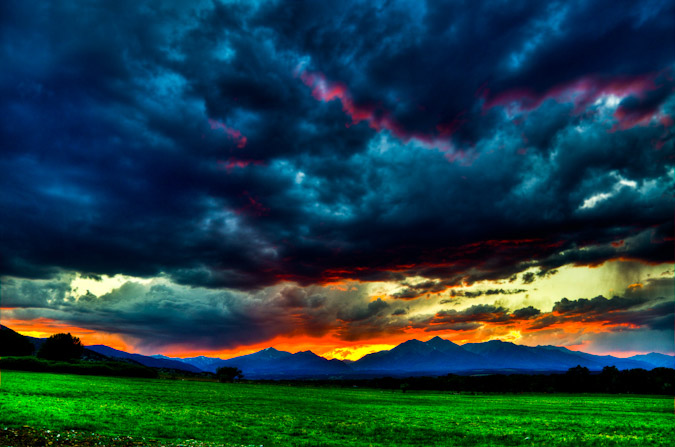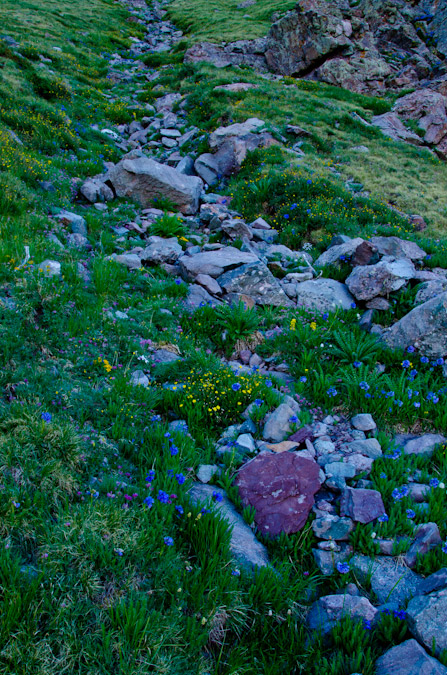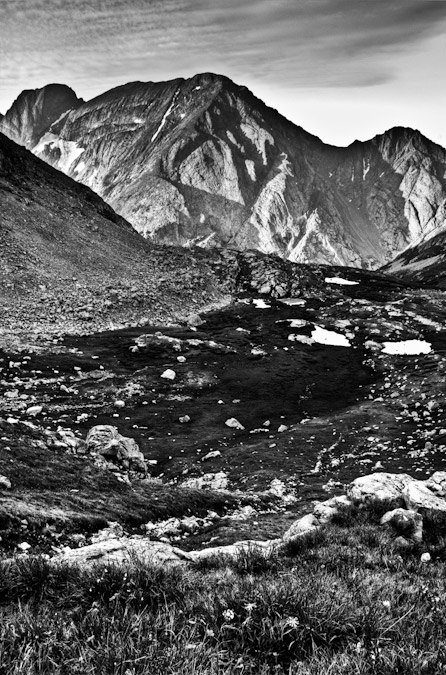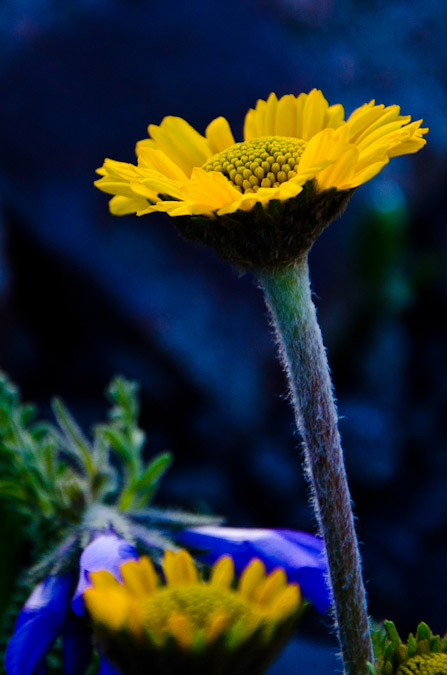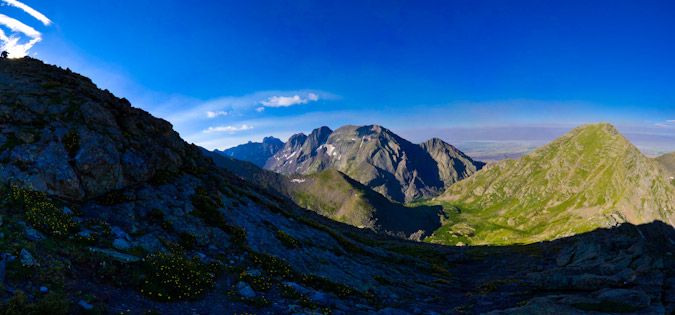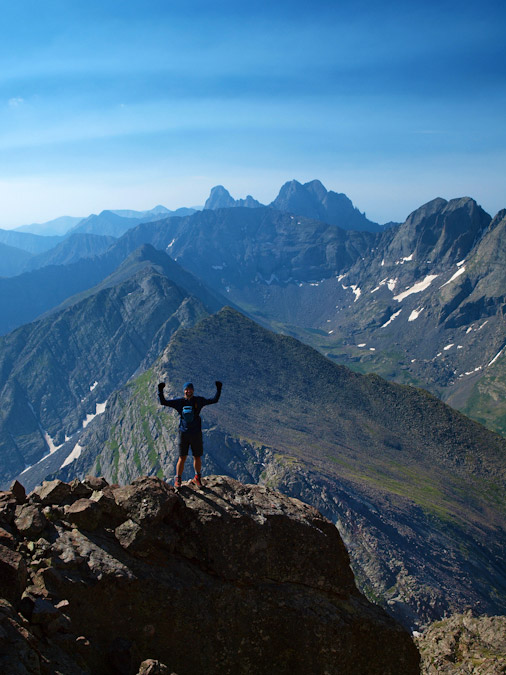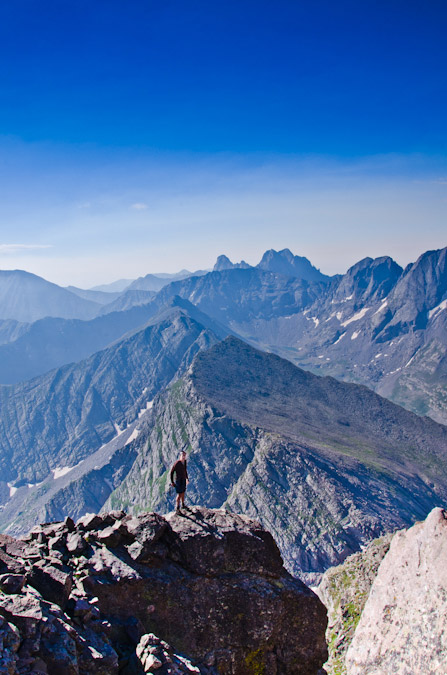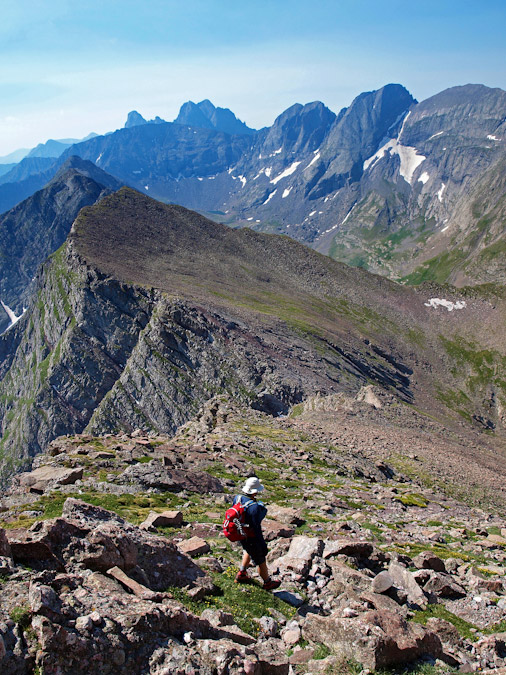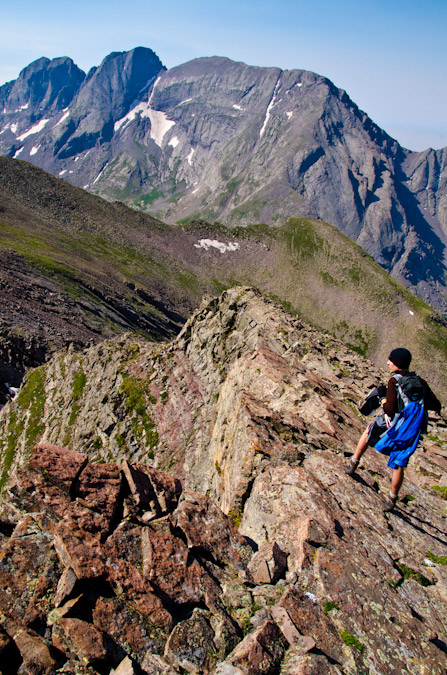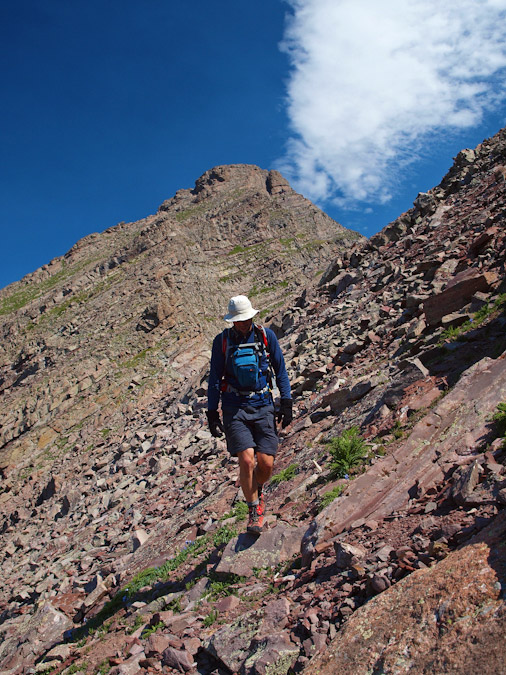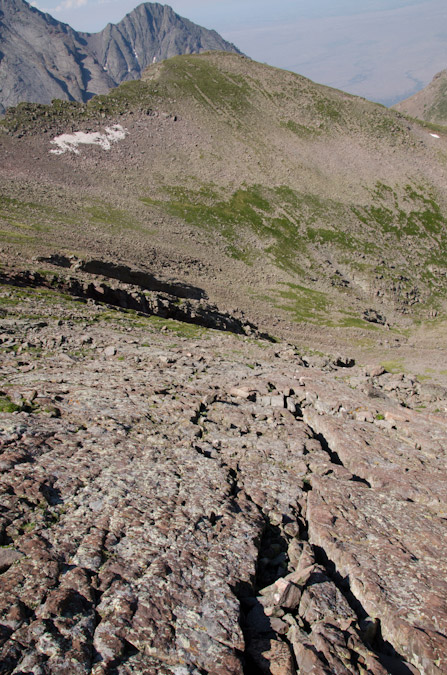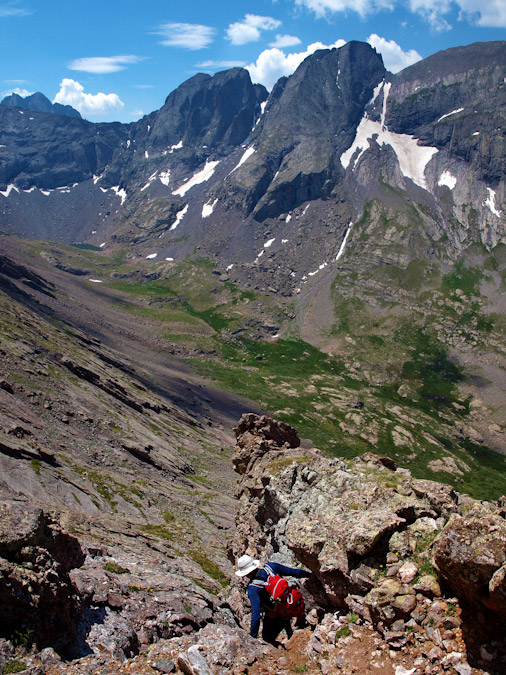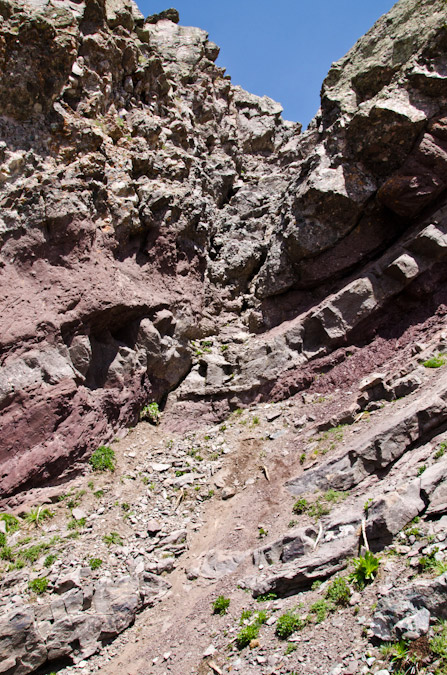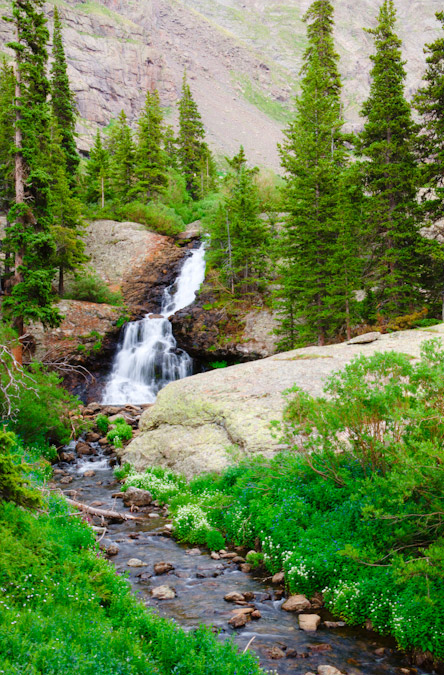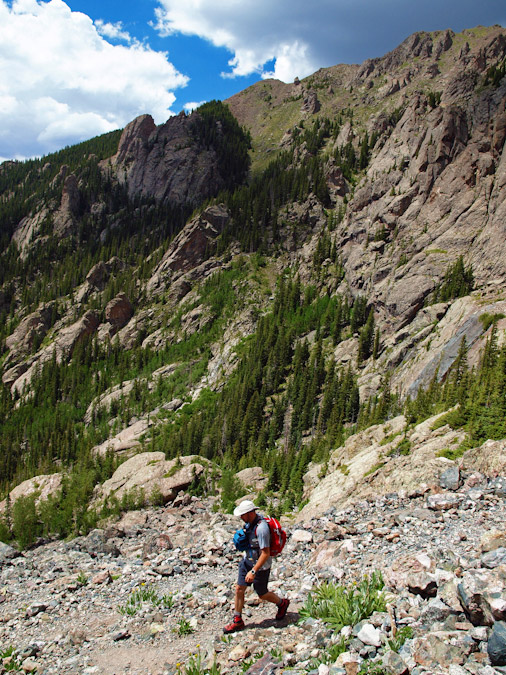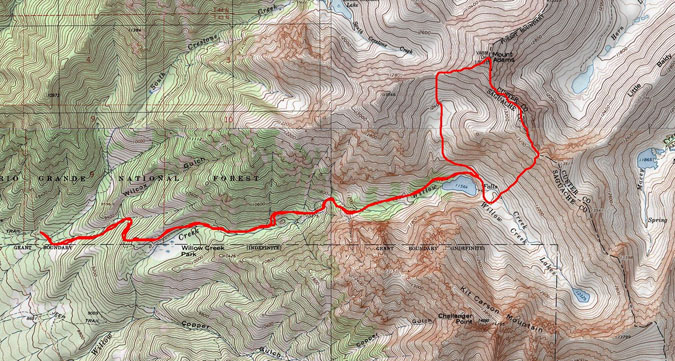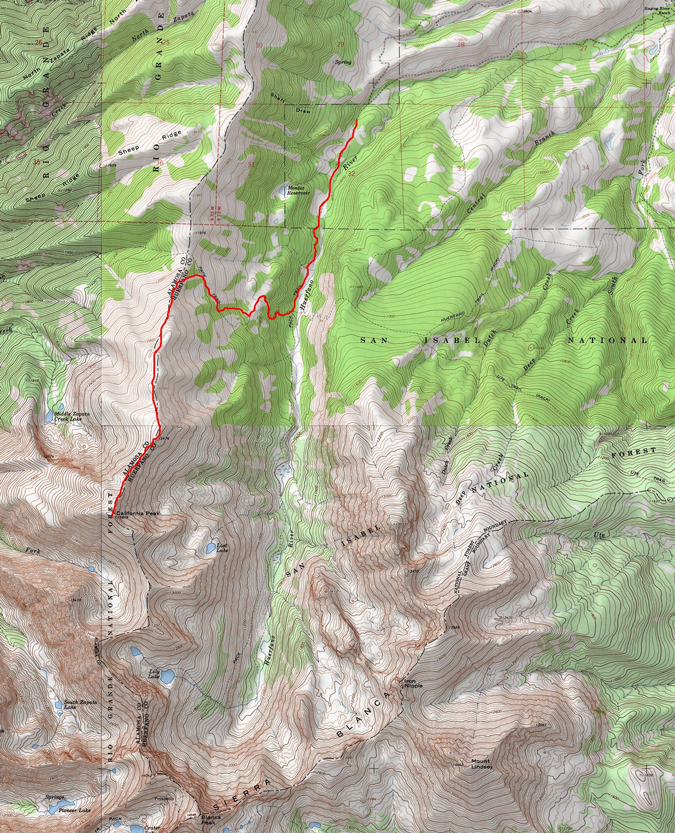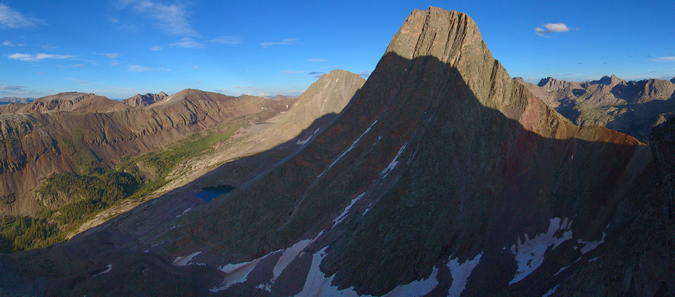Displaying items by tag: Sangre de Cristo
A Mad Scramble in the Sangres - Mount Adams and UN 13,580
Mount Adams is one of the last mountains in the top 100 in the Sangre de Cristo Range that I've yet to climb. It has always drawn my attention on other hikes in the area, and I had hopes of climbing it this spring. Instead, I opted to climb California Peak with Ethan, which was a great hike. Originally, I had planned to climb Pyramid Peak this weekend; however, none of my climbing partners had crampons, so we decided to hit Mount Adams instead. I had always read great things about climbing Mount Adams, and Gerry Roach has the west ridge route marked as a classic climb. Since I have more or less always agreed with Roach's ratings for "classic climbs," I figured that it would be the best way to climb it. So, Ethan and I agreed to take the west ridge route instead of the standard route. Feel free to read more about Roach's 13'er guidebook HERE.
This was particularly exciting since I have wanted to go back to Willow Lake for awhile now. Willow Lake is truly a magical place, and should be designated as a wilderness area, in all honesty. The lake is pristine, with a giant waterfall at its head. Additionally, it is surrounded by some of the most rugged and aesthetically remarkable mountains in Colorado, including Kit Carson Peak, Challenger Point, Columbia Point, Crestone Peak and Crestone Needle, not to mention Mount Adams!
Mount Adams is the 66th highest ranked summit in Colorado, sitting at 13,931 ft. 69 more feet and it would be climbed much more frequently, not that Ethan and I are complaining that we didn't see another soul on the summit...
Looking at the maps while driving over, Ethan and I also thought it might be fun to tack on another peak or two while we were out, so we decided that once we reached the summit of Adams, we would evaluate the conditions and how we felt and then decide on the next steps.
The drive over to the town of Crestone was remarkably unremarkable except for two incredible details. First, the pizza at Amicas in Salida was incredible, as usual. Second, the sunset as we were leaving Salida was insane. We drove out of town, heading west into Poncha Springs, and decided we HAD to pull over and take photos of this rediculous sunset. For my photos, I opted to do a minor HDR treatment since the foreground was quite interesting -we had stopped just in front of a huge grassy area used for cattle to pasture on. The results were stunning, with the sunsetting directly behind Mount Shavano.
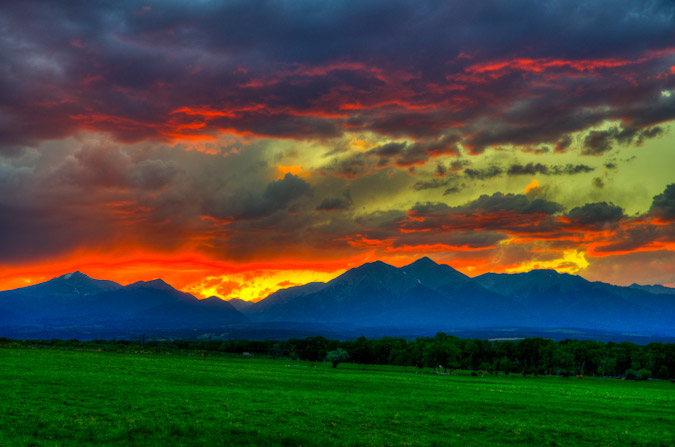
Here's a zoomed-out version of the same scene, which I personally prefer.
We arrived at the Willow Lake trailhead around 10 PM, set-up Ethan's tent, and hit the sack, with our alarm set for 2 AM. We wanted to ensure that we had enough time to reach the summit of Adams before the weather hit. As soon as the alarm went off, we packed up quickly and hit the trail. The hike was an interesting one since there was a full moon and because we did not get a ton of sleep. Nevertheless, we hiked quickly and reached the base of Willow Lake within 2.5 hours.
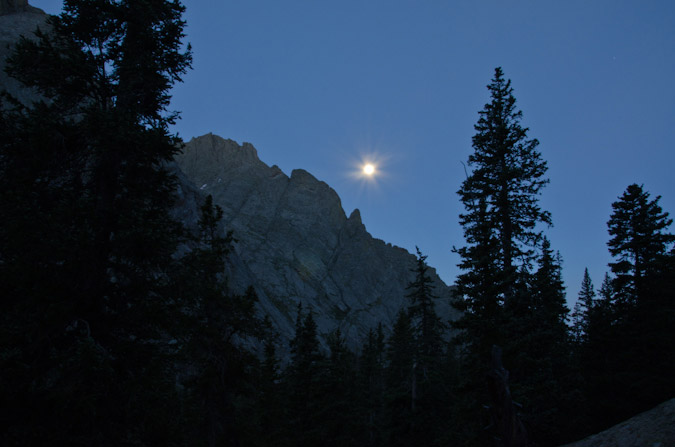
The full moon made for some pretty fun photography opportunities, although photographing the moon is always a big challenge unless you have a really nice zoom lens. Most photos you will see of the moon and of a scene are two images layered as one, since it is literally impossible to photograph the moon and your foreground without either overexposing the moon (like above) or underexposing your foreground. Anyways, seeing Willow Lake again was great. We rested there for a good 30 minutes and took some photos. The waterfall was just as awesome as I had remembered it to be.
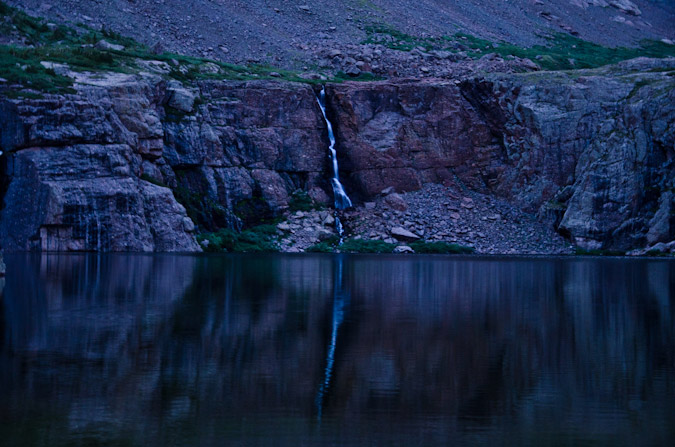
We saw lots of tents on the way up, probably 15 total. Lots of people were up here to climb the 14ers. We were the only group doing Mount Adams though. We gained the trail to the left of the lake and began to ascend above the lake in quick order, stopping every once in awhile to get some photos.
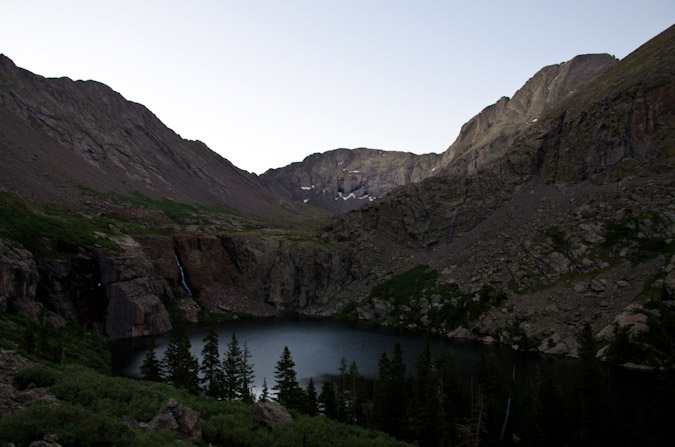
Before we knew it, we had gone too far and were nearly at the head of the lake near the waterfall. While we knew we were somewhat off-route, we decided to get into a good position to get photos of the sunrise and the full moon over Willow Lake.
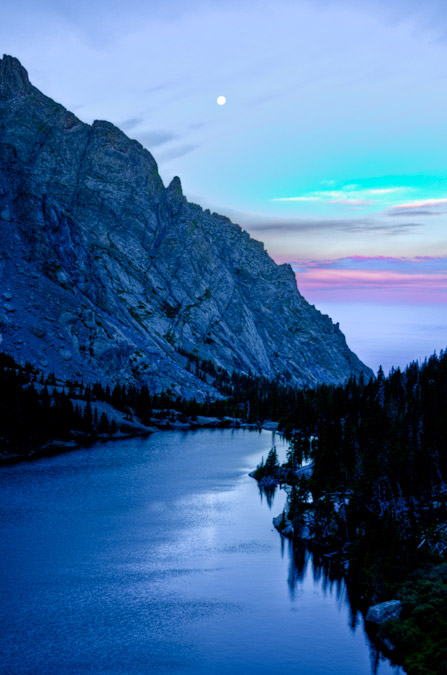
We then turned sharply south to gain elevation into the small basin beneath Mount Adams. Since there is no trail up there, we just followed beneath the termination of a large cliff wall that led into the area, looking back from time to time to catch the sunlight on Kit Carson Peak.
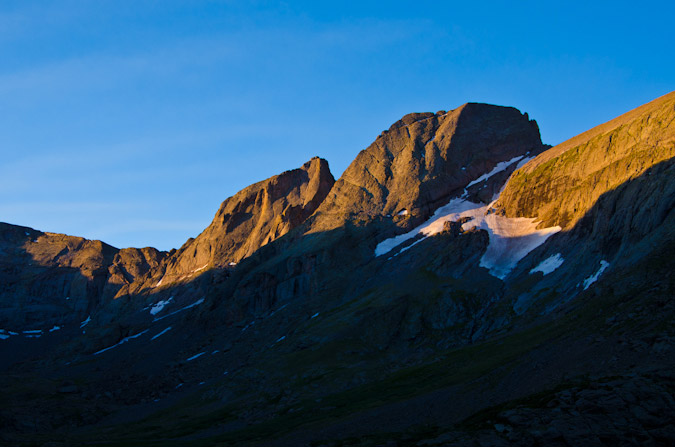
I've always like the geology of this area, which is comprised of clastic sedimentary rocks, which appear as large pebbles that are cemented together. These rocks sometimes erode, to leave behind some really interesting features. For more information on Crestone Conglomerate, check out this interesting website.
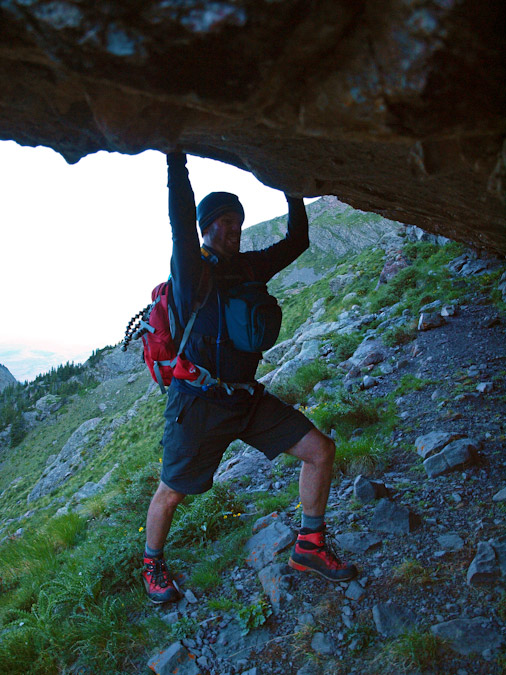
As we gained the basin, we could not help but notice the amazing hues cast onto Willow Lake by the sun hitting the southern aspects of Challenger Point.
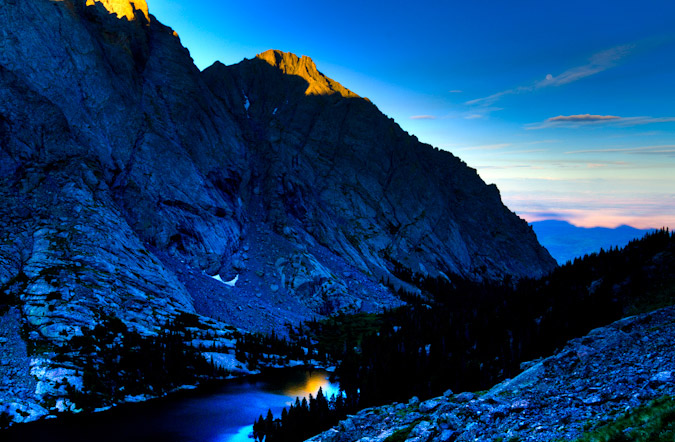
Indeed, the alpenglow on KIt Carson Peak and Challenger Point were quite impressive, and coupled with the moon and the lake it made for a perfect scene to hone my HDR skills. If you've ever wondered how to do HDR, you can do like I did, and read about it a ton, or watch this perfectly succinct tutorial from Trey Ratcliff.
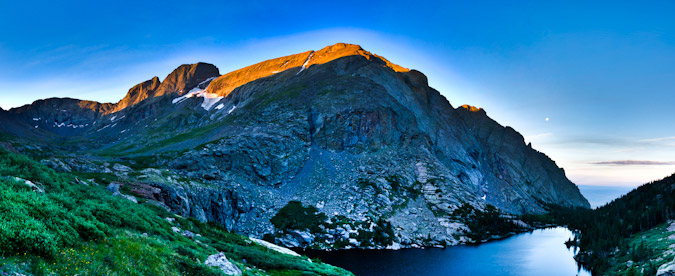
We kept on hiking up into the basin towards Mount Adams and stumbled upon a pair of really nice looking ponds. The ponds were surrounding by wildflowers and separated by a huge jutting rock feature, which made for quite a lovely subject for an HDR panoramic. Additionally, the clouds were insane, and continued to be all day long.

After a few more minutes, Mount Adams finally came into view for the first time.
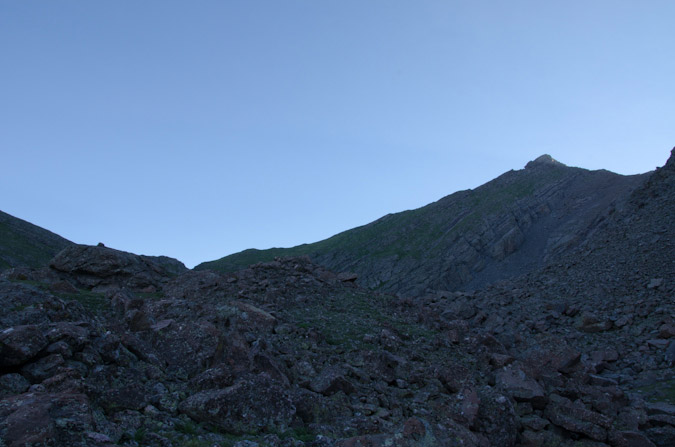
The route seemed quite straight-forward to us, so we opted to just follow a rock gully up towards the ridge, which was strewn with all sorts of wildflowers.
|
|
|
Ethan was a superb photography this day - he captured many many photos of me throughout the journey, all of which I really enjoyed his perspective and composition on.
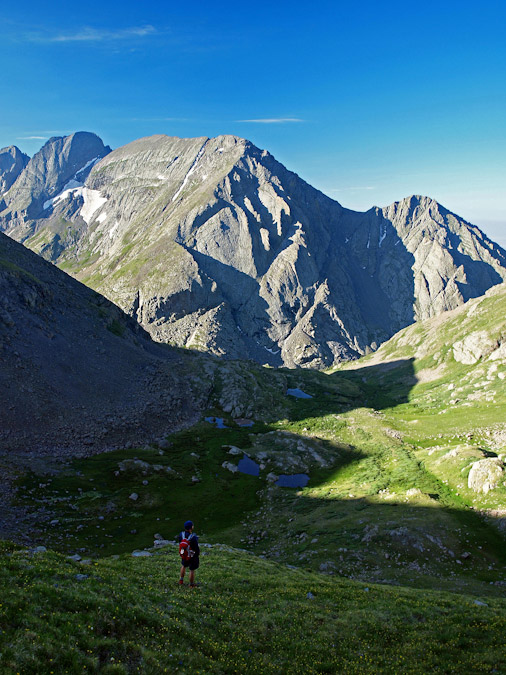
We finally gained the ridge!
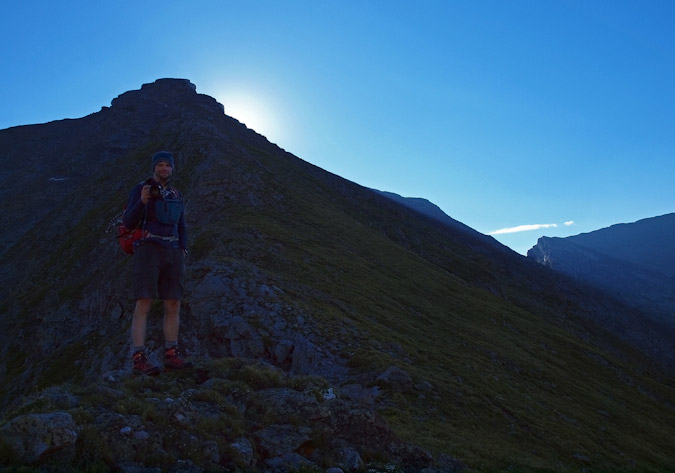
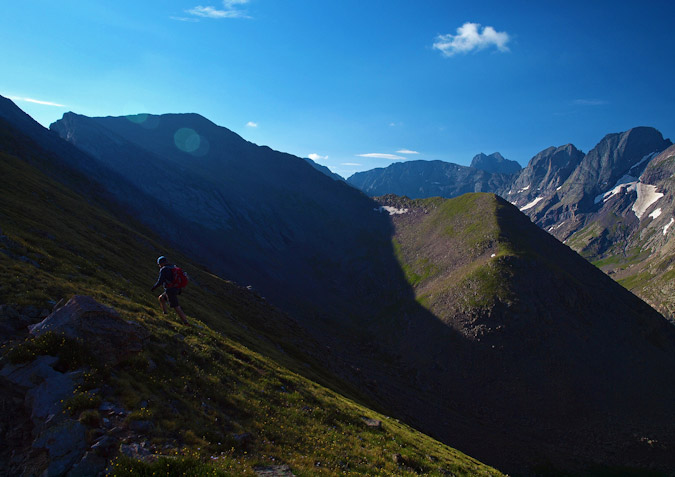
We were able to look down at South Crestone Lake and some 'miniture' Crestone Needle looking mountains.
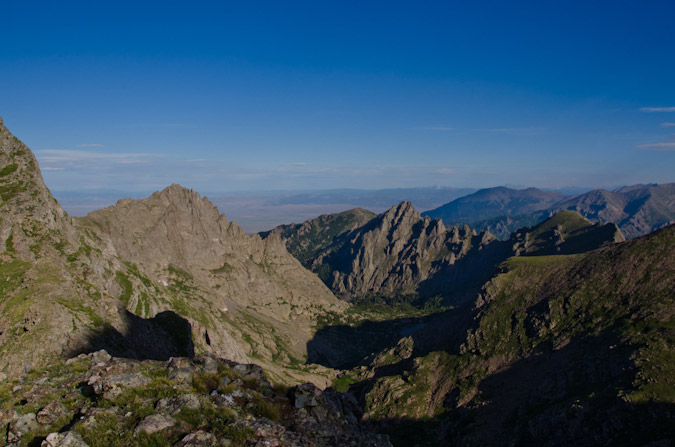
As we continued up, Crestone Peak came into view, and eventually Crestone Needle as well.
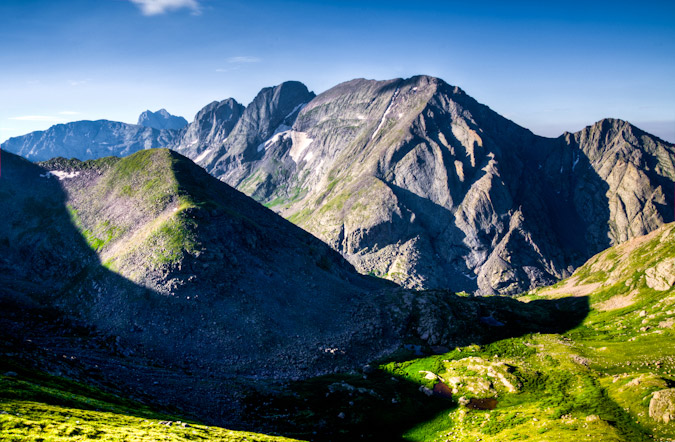
The wildflowers on Mount Adams were amazing.
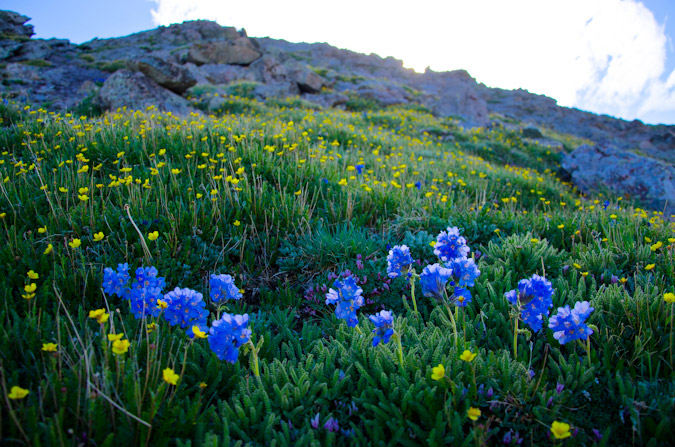
|
|
|
And the route up the west ridge was fabulous. In some sections, it really reminded me of Crestone Needle, just not as steep. The same type of rocks made for some enjoyable route-finding. I shall hereby dub Mount Adams, "Baby Crestone Needle." The similarities in the rock were remarkable.
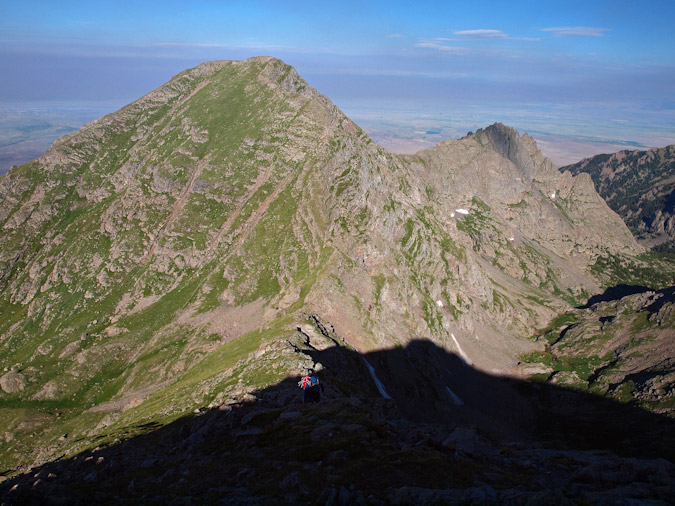
The clouds continued to look awesome, and so I was able to get this photo of Ethan gaining the ridge higher up.
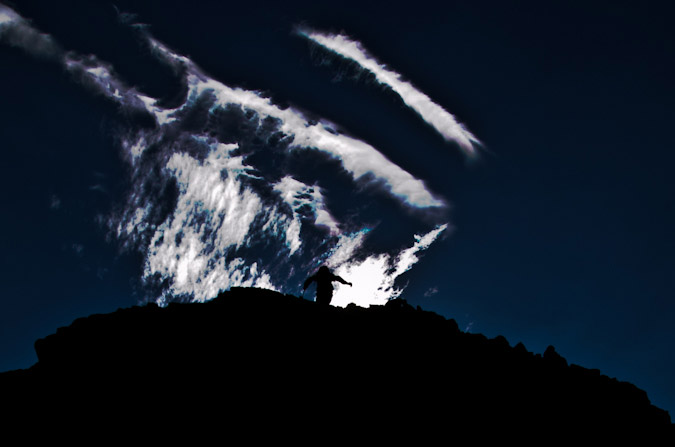
I was also able to get a really nice panoramic photo of Ethan gaining the ridge with the nutty clouds behind him. Click to see a larger version.
Check out this cloud - it looks like its going to eat my soul - thanks Ethan!
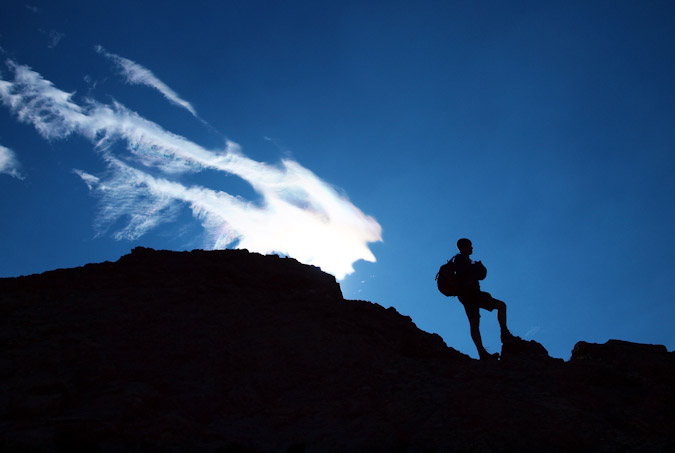
We stopped frequently to shoot photos. This is an all too familiar scene - me shooting photos of flowers. Thanks for catching me in the act, Ethan!
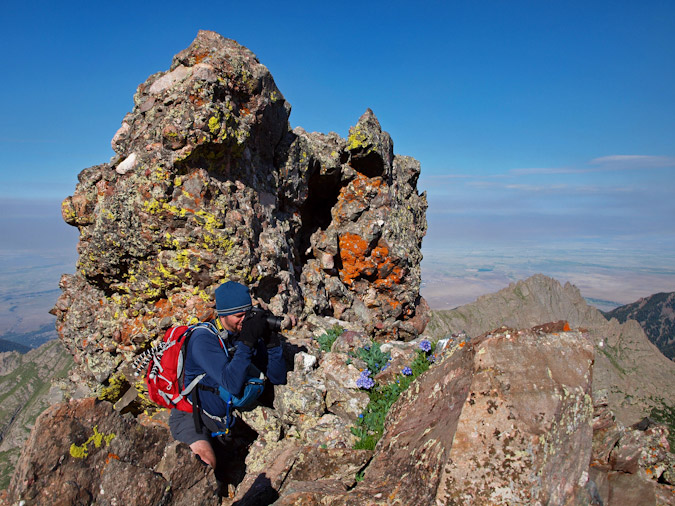
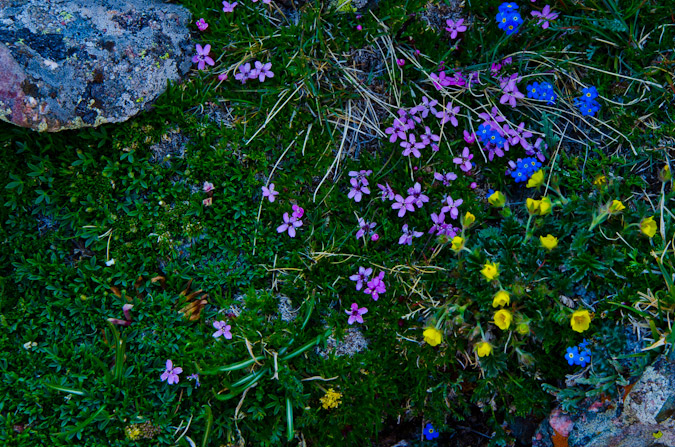
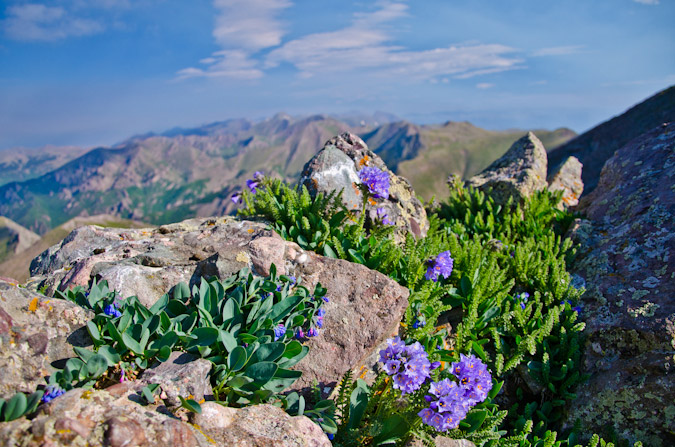
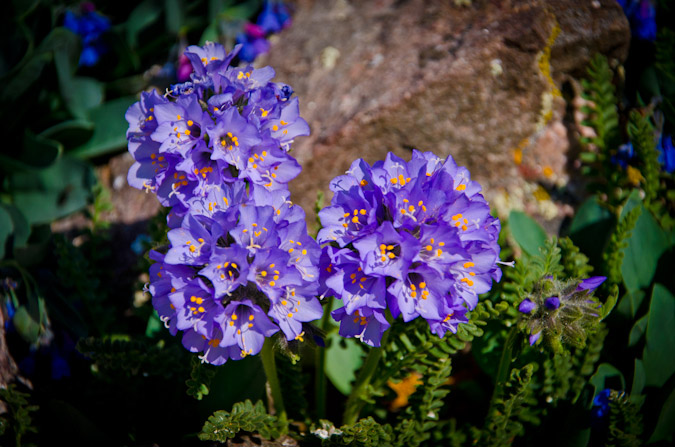
We kept on truckin' up to the summit block, which proved to have some enjoyable class 3 options if one so chose, so we did.
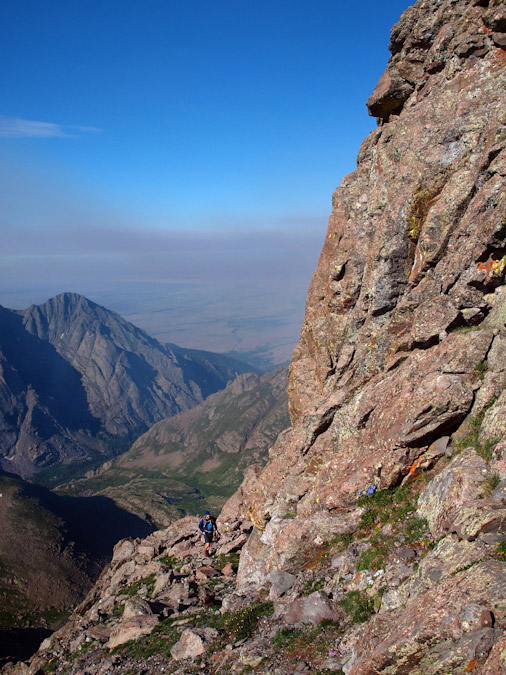
Finally, we reached the summit and took a congratulatory summit shot using Ethan's camera on self-timer.
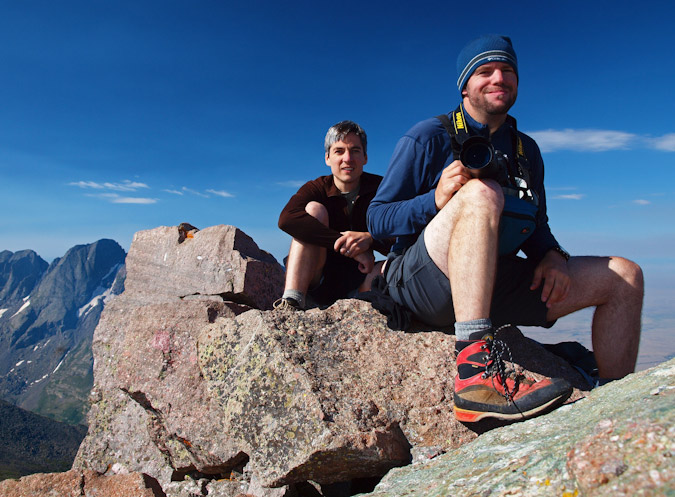
Mount Adams was a great climb, for sure. The summit was superb, with excellent views in all directions.
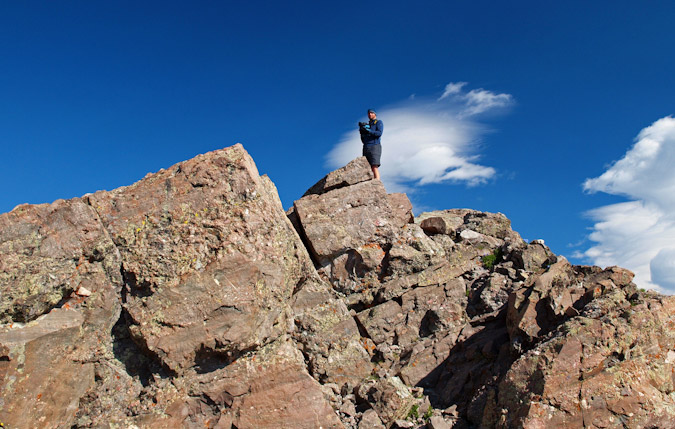
We also had some insane smoke appear out of nowhere in the valleys around us, and before we knew it, the smoke was gone. It was truly odd. It was almost as if the valley below was on fire and then put out before we knew it. A look to the north revealed some crazy looking clouds over Rito Alto, Venable and Comanche.
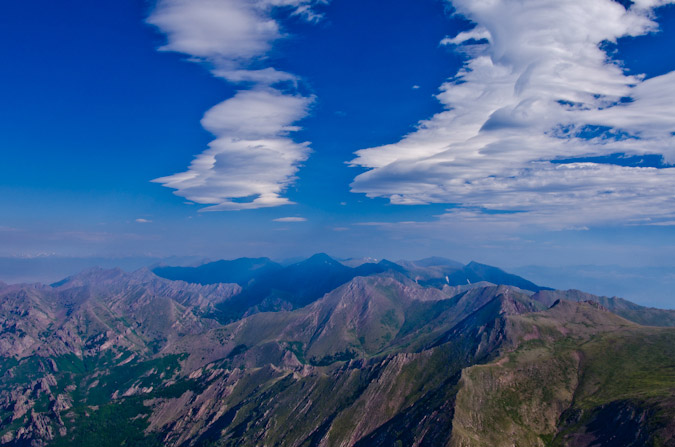
We also found an awesome spot with a great vantage point for a celebration pose. We took advantage and marvelled at the sheer depth below us from where we stood.
|
|
|
Naturally, my focus was on Crestone Needle and Crestone Peak, two of my favorite mountains in Colorado. They are so distinguishable and quite honestly some of the freakishly looking peaks there are in Colorado. In fact, Crestone Needle ranks just 4th on the "Most Impressive" list (for ranked peaks) that is based on the work of David Metzler and the ORS/RORS scales.
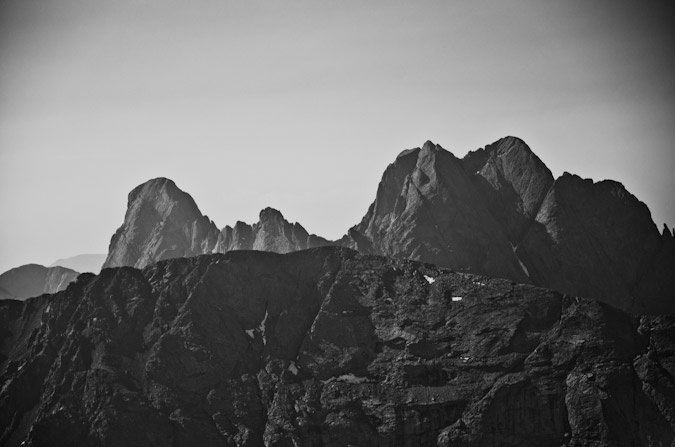
A view to the east revealed Fluted Peak (far left), Horn Peak (left, in distance) and the Horn Lakes below. UN 13,580 (ranked 201) was directly south, with UN 13,541 and Obstruction Peak and Humboldt behind. Additionally, Crestone Needle and Crestone Peak stood out like sore thumbs with Columbia Point, Kit Carson Peak and Challenger Point all towering over the basin below.

A closer look at the 14ers of the area. Left to right - Crestone Needle, Crestone Peak, Columbia Point (13er, ranked 56th), Kit Carson Peak and Challenger Point.
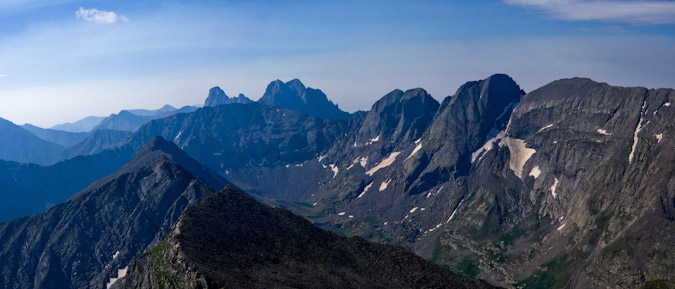
Ethan was loving the views and the clouds.
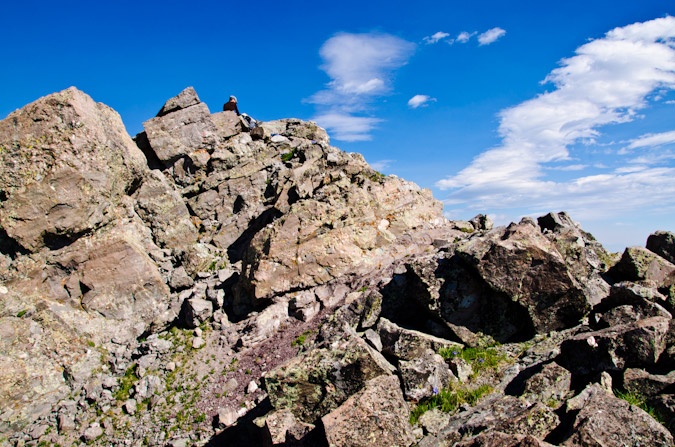
And so was I...
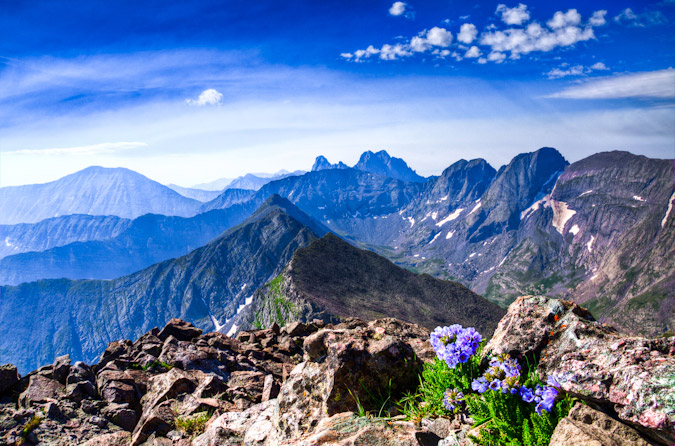
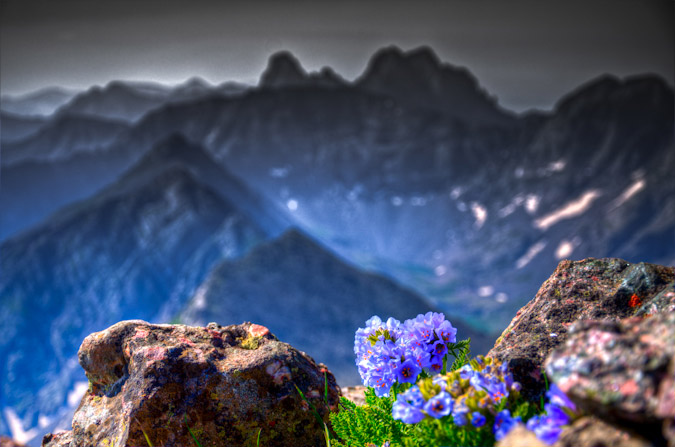
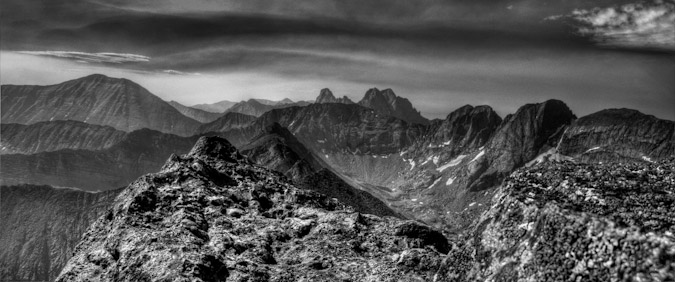
Alas - a perfect summit does not last forever, so we decided to head south towards UN 13,580 and beyond to see what we could accomplish. The dramatic nature of the cliffs to our left kept us on our toes and in amazement for quite a long distance.
|
|
|
Also, the traverse over to 13,580 proved to offer some really fun challenges, including this class 3 manuever above a hugely exposed section.
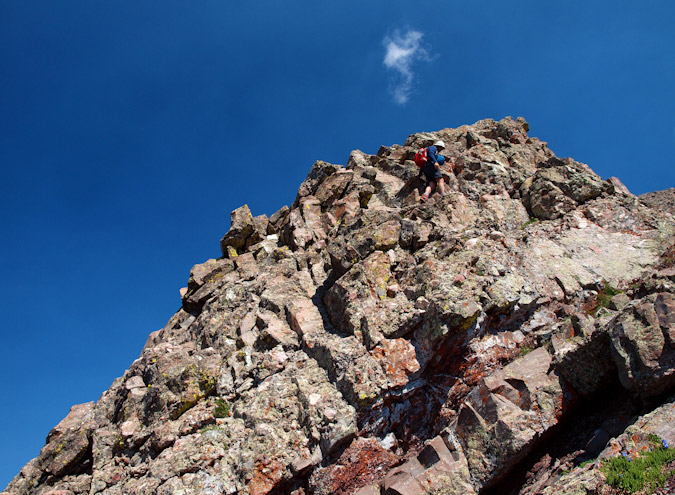
But it also offered some fun boulder scrambling on very solid rock.
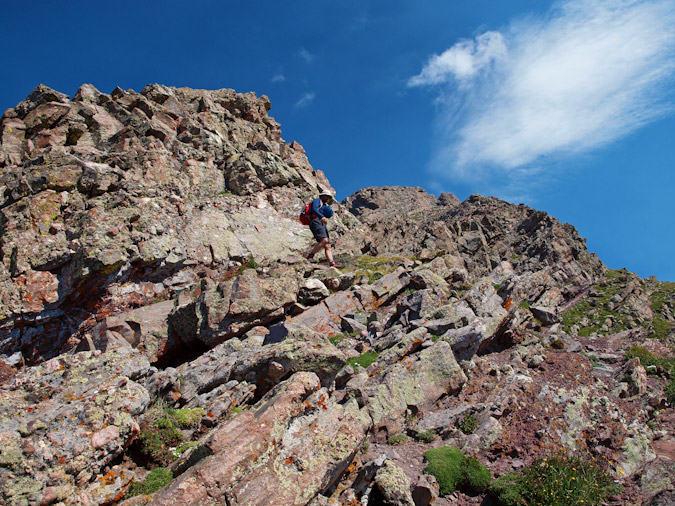
UN 13,580 was not too far from us, and the views kept us from moving too quickly.
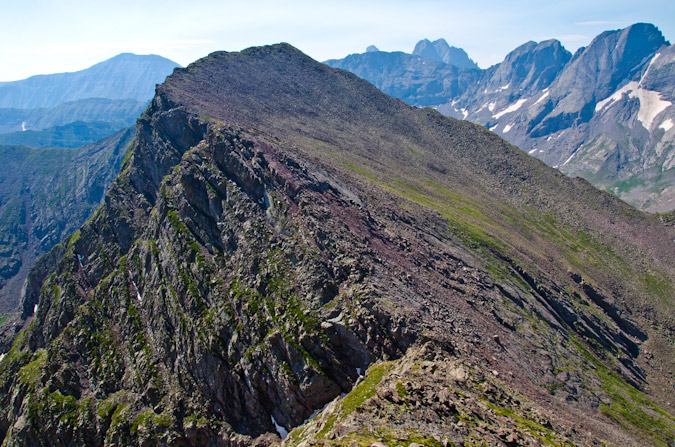
The rock was all totally solid, but in places it was awkward walking on slanted slopes of what felt like giant fissures in the earth.
|
|
|
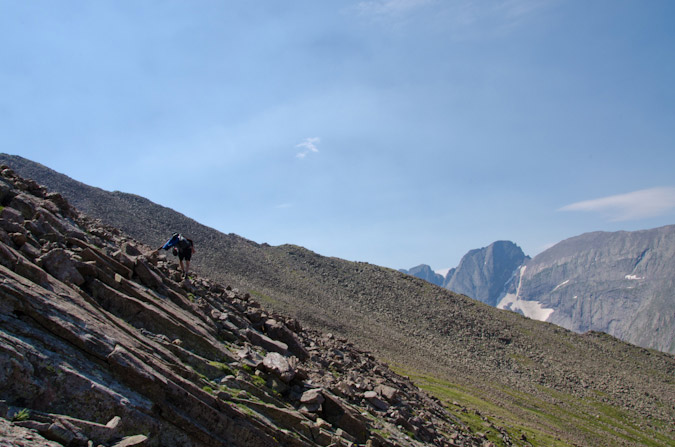
A look back at Mount Adams...
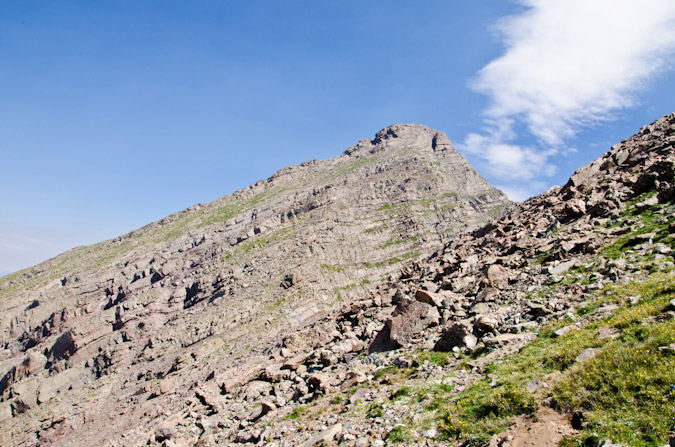
We finally reached the summit of UN 13,580 and enjoyed as what Gerry Roach describes on page 155 as "a startling view of Horn Lake." I don't disagree with Roach one bit on this detail, but what I do disagree with him on is that he describes UN 13,580 as a bi-centennial, meaning it is in the top 200 in Colorado ranked by elevation. According to my list, it is ranked 201 and just shy of that mark. When I built my database, I ranked mountains in the following order:
- By elevation
- By prominence
- By isolation
- By name
So, if two mountains had the same elevation and prominence, the mountain with more isolation is ranked higher. This seemed like the most fair way to rank mountains that had very similar characteristics. I am not sure how Roach or any others rank them.
Subsequently, according to my database, which is based almost entirely off of data compiled by John Kirk of Listsofjohn.com, Clark Peak, a 13er in the Elk Range, is also sitting at 13,580 ft. Additionally, it has the exact same prominence as UN 13,580, making them tied in most regards. The mountain with more isolation (Clark Peak) gets ranked higher.
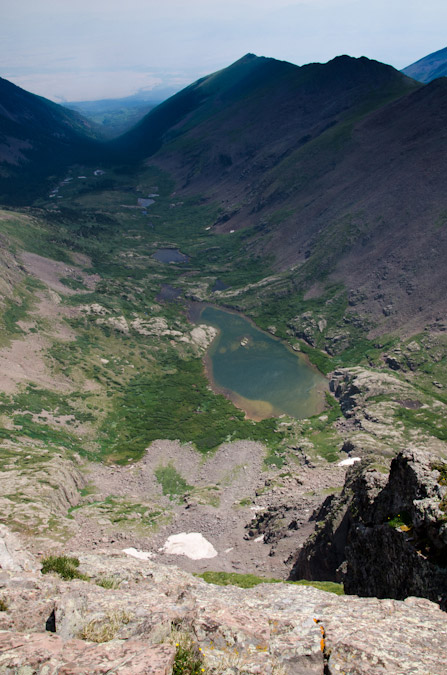
Sorry to get on that soap-box... here's a self-timer of Ethan and I on UN 13,580.
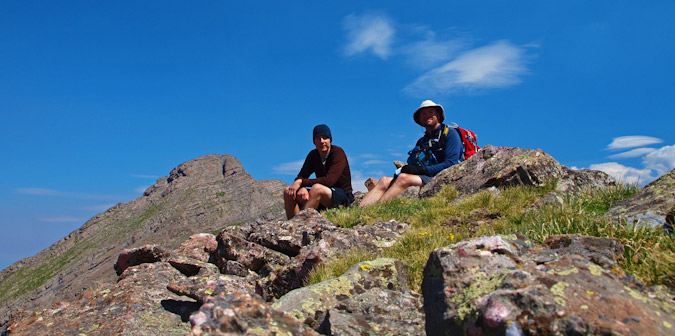
And Ethan with the Crestones in the background...
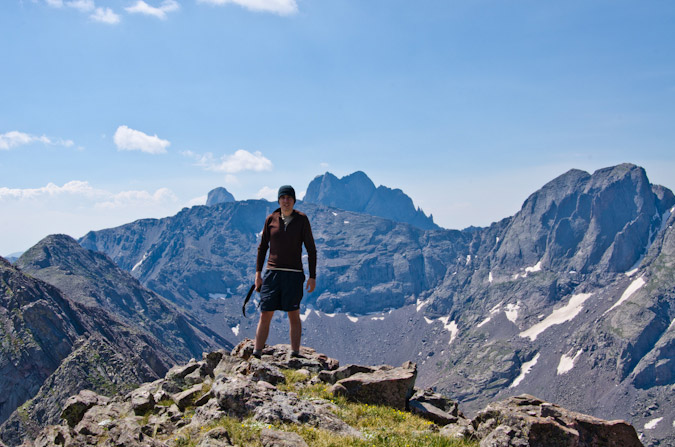
With me enjoying the "startling views."
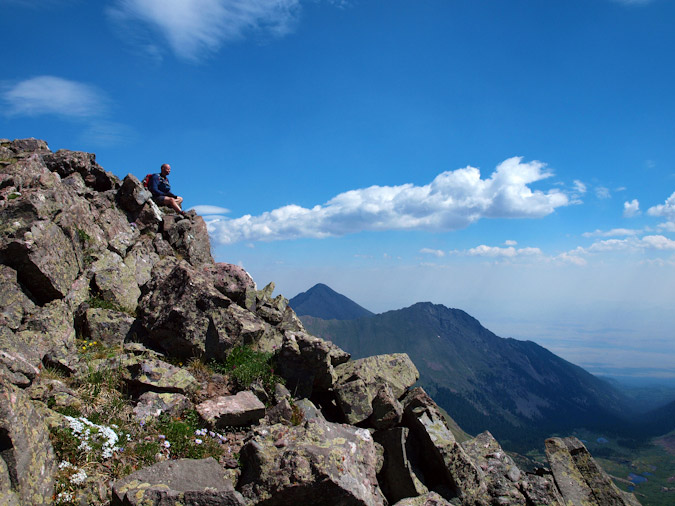
It was really cool signing the summit register for this rarely climbed peak. At the top of the register was Gerry and Jennifer Roach, followed later by John Kirk (of ListsofJohn fame), Susan Joy Paul (a regular on 14ers.com and a Facebook friend), and Doug Hatfield, another regular 14ers.com contributor who quoted on the summit register, "100/100 in Custer County," meaning, this was the last ranked peak in this county that he needed to finish. Quite an accomplishment!
Naturally, the Crestones just kept my gaze for much of our time resting on UN 13,580, so I decided to get some more HDR shots, as well as a non-HDR shot.
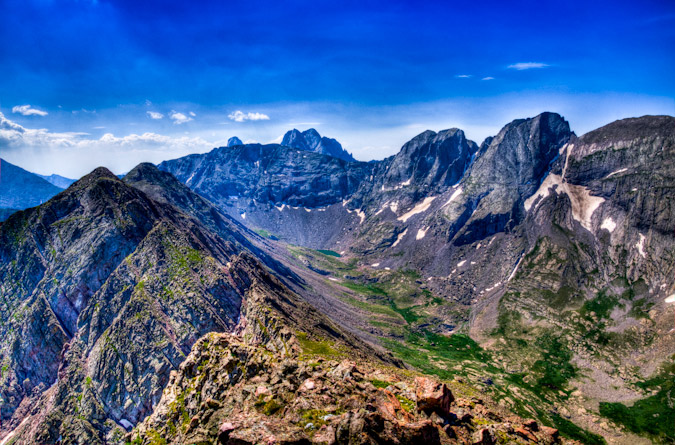
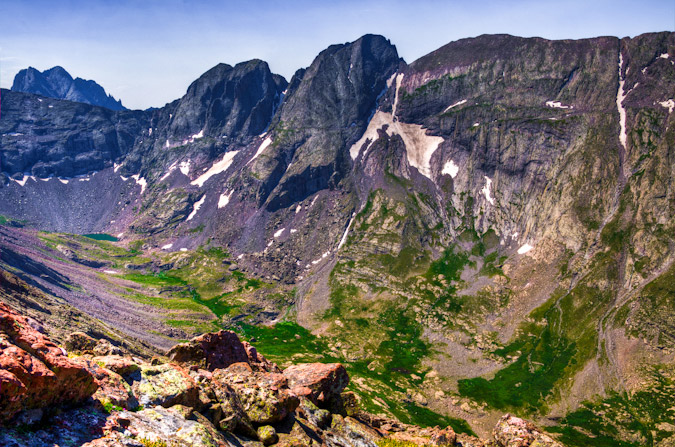
We decided to keep going along the ridge to see where it would take us. Much to our surprise, a lone goat crested the ridge to greet us below to the south.
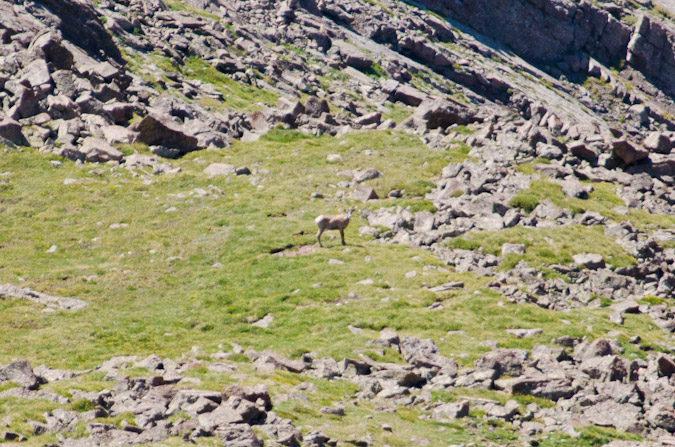
"We're gonna climb that one now?"
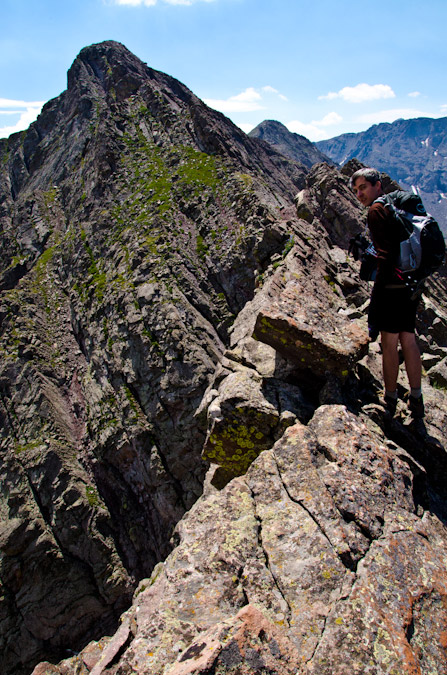
Unfortunately, the storm clouds starting building to the west, so we opted to bail at the first opportunity. Since there's no trails in this terrain, we had to do some heavy route-finding. This ended up being quite enjoyable and challenging, and afforded us with plenty of class 4 down-climbing opportunities.
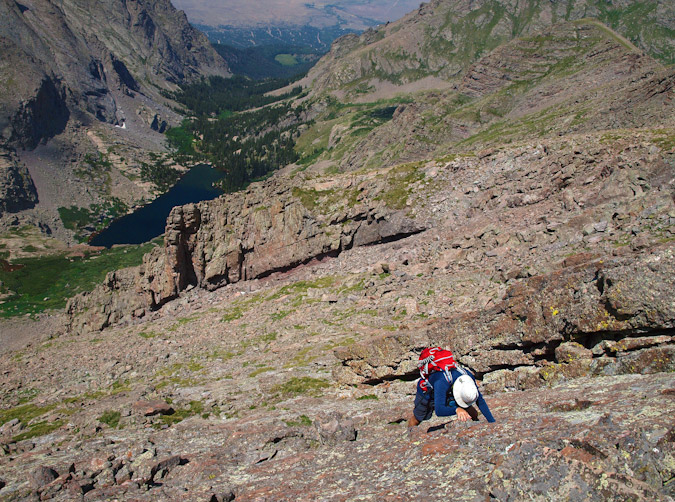
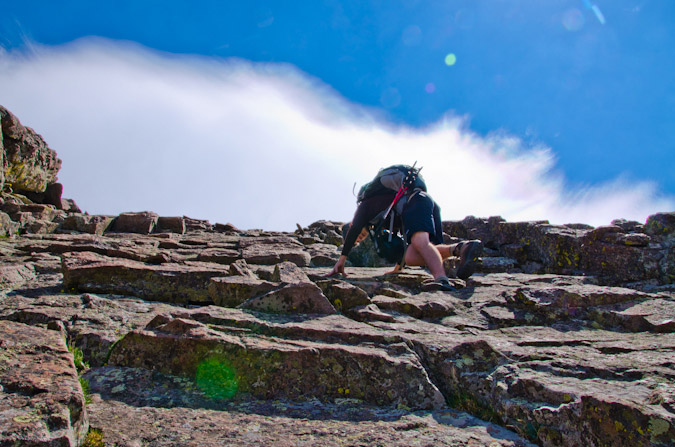
We found a crazy gully just below the first set of slabs we had down-climbed, and decided that the terrain on the other side of this mini-ridge below the gully looked much better as an exit. Unfortunately, the gully was loose and chossy, with eroded garbage and hardened mud. It was a real nightmare to downclimb. I went first, and faced-in for many sections. I kicked down tons of loose debris and tested every hold. It was quite a mess. Once I was down, I yelled up to Ethan that I was clear. Ethan had a bit more trouble, mostly because he was schlepping his trekking poles on his pack still (I opted to not bring any), and his camera bag was not of the LowePro Toploader variety that I have grown to love. His bag got into his way and he had to stop and re-pack the whole thing into his main pack. Almost down, Ethan had a few more moves left. He faced in and placed all of his weight on his feet, which were being held by what appeared to be a very solid and large boulder. Ethan shifted his weight to another rock, and as he did, the rock he was just standing on crumbled and disintegrated, causing huge blocks to go down the rest of the gully and down the mountain. Ethan was quite lucky. Here's some views of the nasty gully:
|
|
|
After the lame gully, we were greeted by a series of steep ledges that had interesting holds, probably rated at class 3 or 4.
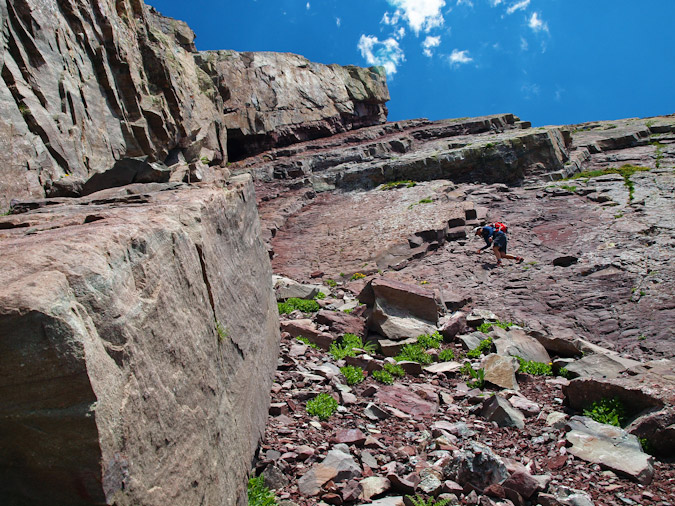
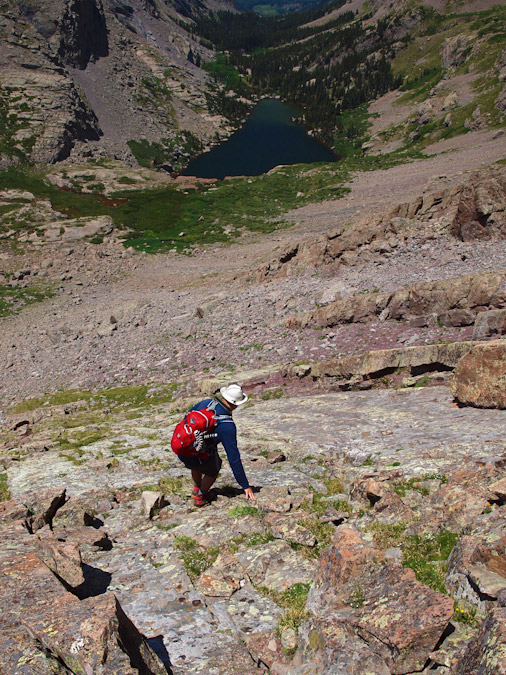
A look back up the ledges:
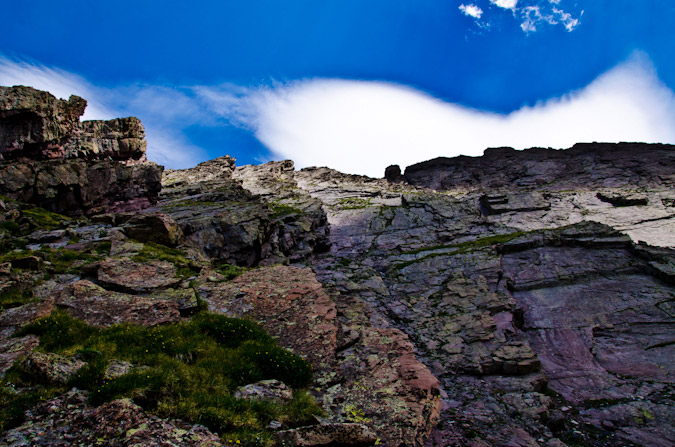
And over to Kit Carson and Challenger...
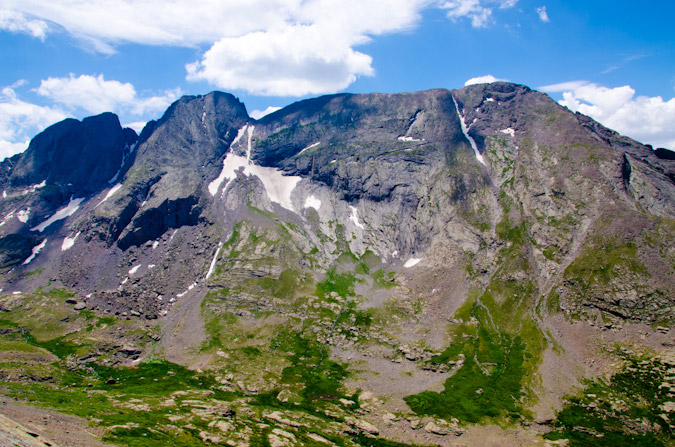
We descended this section pretty quickly, having to shift directions a few times due to the bands of ledges terminating a few times. I rested a few minutes at the base of the boulder field we came down and found a new friend.
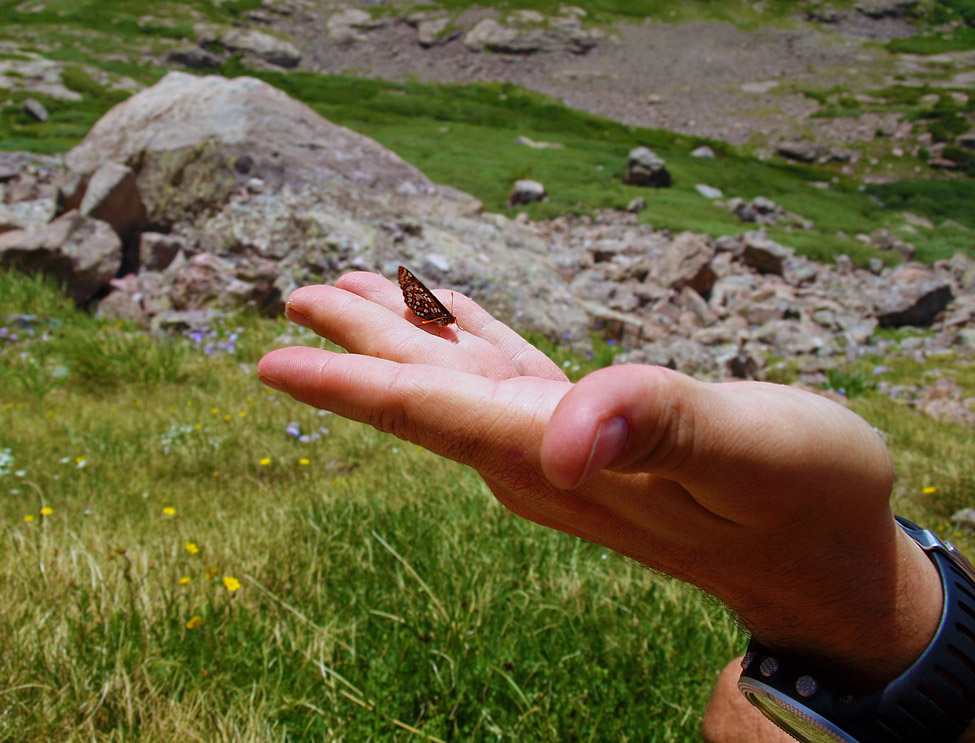
The columbine flowers were really nice too!
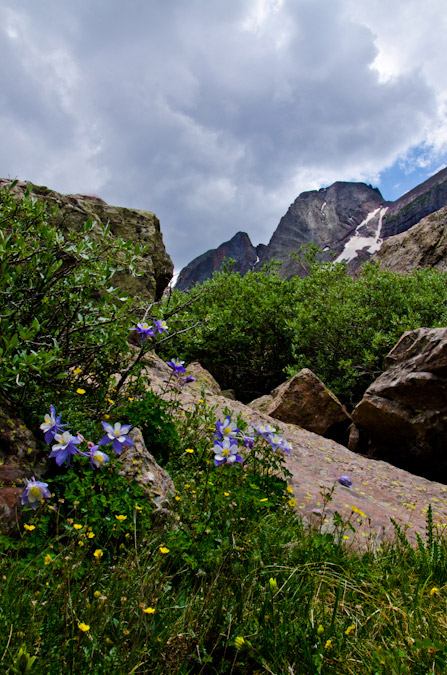
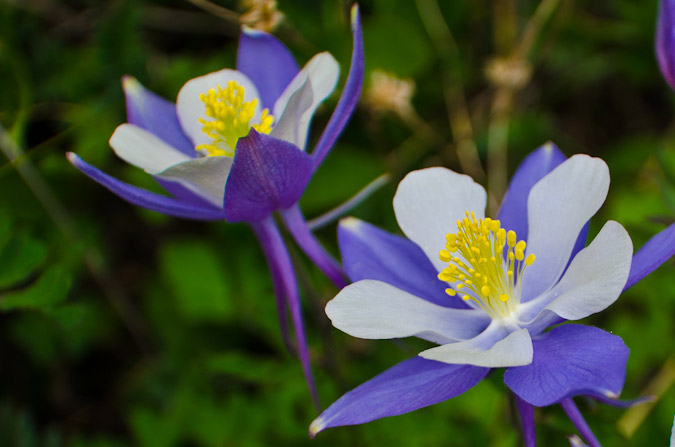
Another look back up the insanity we down-climbed...
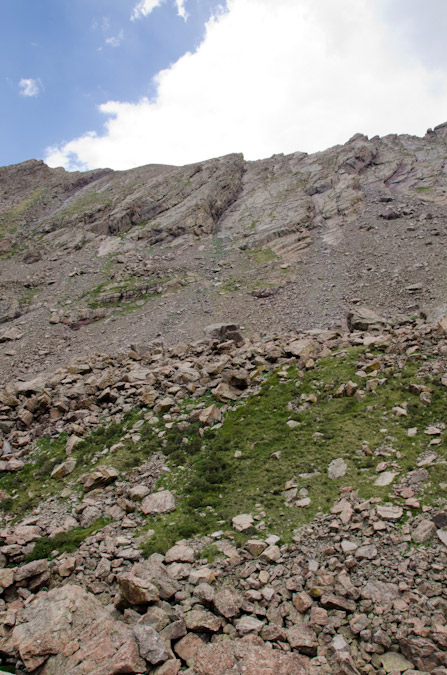
We re-joined the trail that leads up to Challenger Point and headed towards the waterfalls above Willow Lake.
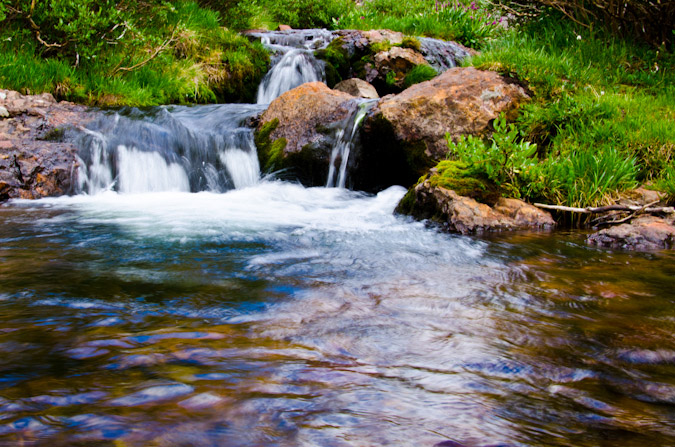
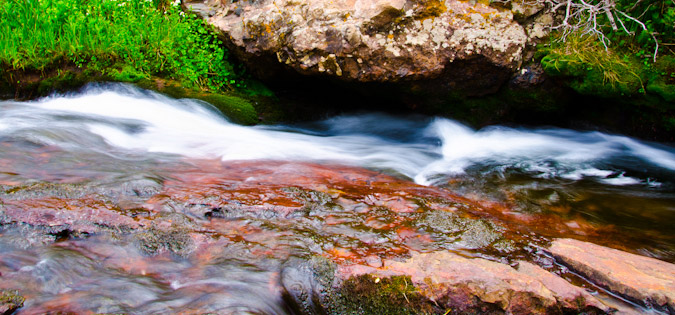
Which were quite amazing!

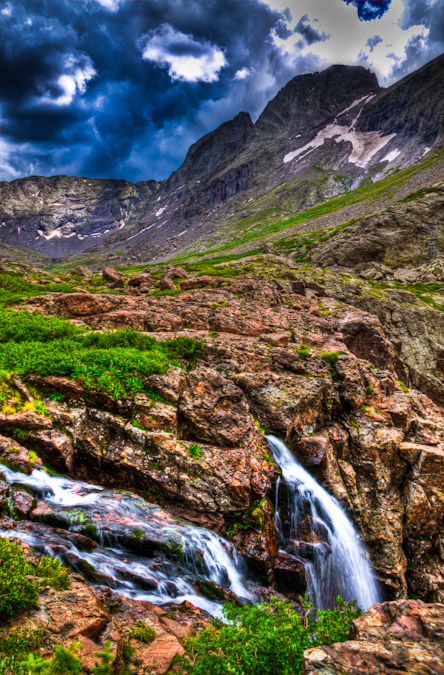
Finally, we made it back around and to the lake in short order.
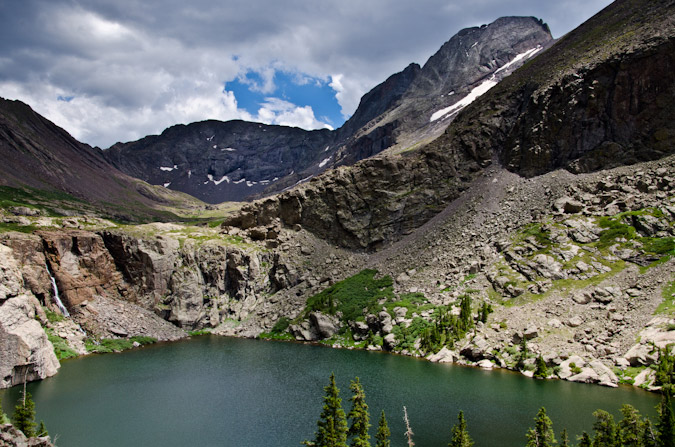
When I was here in 2009, I took a panoramic photo series from the lake, which included the waterfall and a really interesting rock in the lake. I always regretted that photo because it cut the top off of Challenger Point. Not this time!

Also, we stopped below the lake to get some amazing shots of the lower waterfall near the trail.
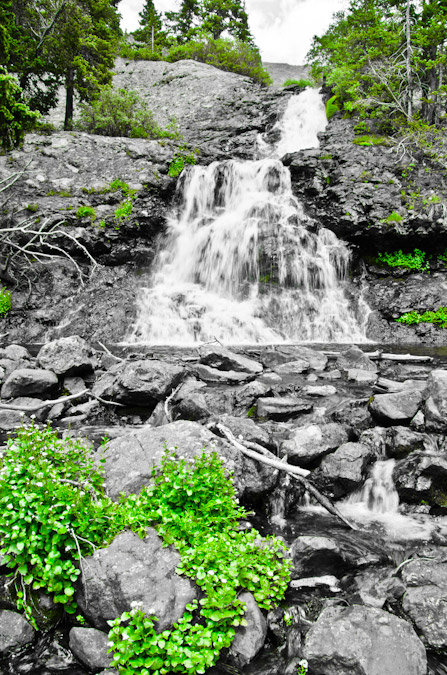
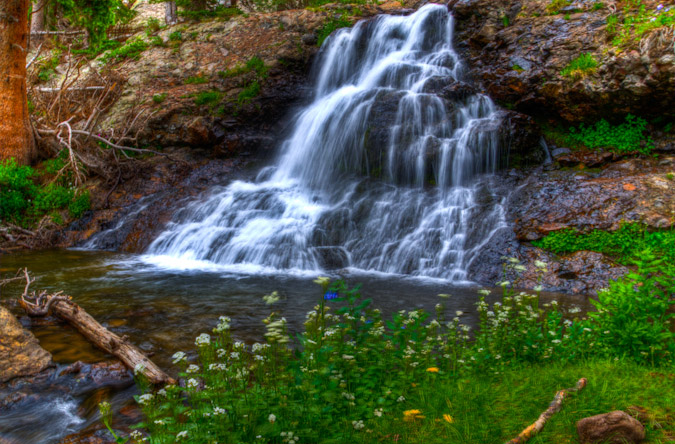
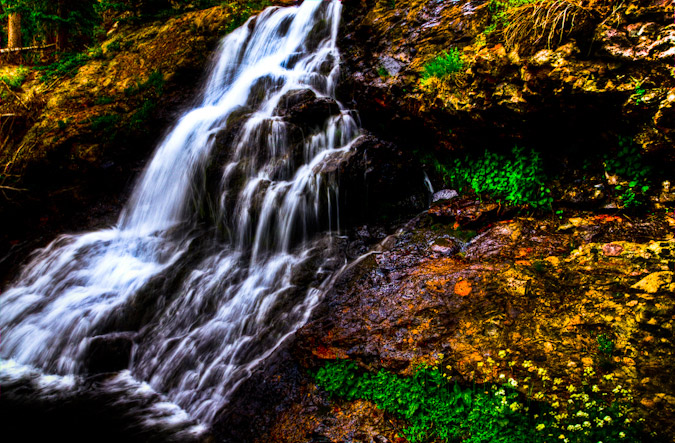
The hike out was pretty uneventful after the waterfalls, except of course for the insane amount of switchbacks on the lower trail. We made it back to the car at 4 PM on the nose, just 14 hours after we started...
|
|
|
Here's a look at the map, showing our route and elevation profile. Feel free to click on each to see larger versions.
As always, if you liked this report, please feel free to follow 100summits on Twitter or Facebook! Also, if you're planning on doing any online shopping and if you enjoyed the content, please help keep the site going by using the links on this page to help fund the site. And last but not least, if you are interested in purchasing photography from me, please take a moment to read this page for more details. Thanks for stopping by!
California Peak - a Sangre de Cristo warm-up
California Peak has long eluded me. Being one of the highest 100 mountains in Colorado (a Centennial), it has been in my sights for awhile. California Peak rises to 13,849 ft. and is ranked 84th highest in Colorado based on my list of the highest 100 mountains in Colorado. Over the past two years, I've set eyes on it numerous times, first from the summit of Lindsey, Iron Nipple and "Huerfano," and later from the summits of Ellingwood Point and Blanca Peak, all close neighbors of California Peak. I had hoped to climb it back in 2009 with my wife, but those plans were foiled by some hoodlums shooting guns at me and my family. I also wanted to climb it in 2010, but those plans were foiled by a seriously bad weather outlook that forced me to stay home. So, a few weeks ago, my long-time hiking partner, Ethan Beute and I made plans to climb California Peak. Our plans to climb it two weeks ago were completely thwarted by forecasted 100 MPH winds and again the following weekend due to snow. Alas, this weekend came and we pulled the trigger, with highs forecasted in the 40's for California Peak and wind gusts of up to 40 MPH. Not knowing how much snow was on the trail itself, we both packed our MSR Lightning Ascent snowshoes and a great deal of winter gear. We both also brought our Outdoor Research gaiters, expecting to encounter a fair depth of snow. I scoured the internet for trip reports for California Peak in April and found none, so we really had no idea how much snow would be on the trail or the road. I met Ethan at his house at 3:45 AM and we left for the beautiful yet dangerous Huerfano Valley. We were not sure what the road would be like, so we were very concerned with how far we could get his vehicle, given the last report stated the road had significant snow drifts fairly far from the trailhead. At 6 AM, we were able to make it to within about 2 miles from the trailhead just as the first views of Blanca Peak came into view.
Ethan snapped a great photo of California Peak and Blanca Peak (right to left respectively):
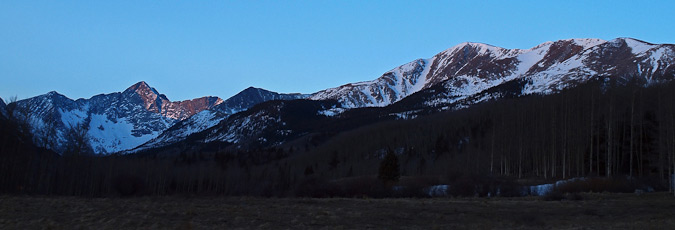
I was very pleased with this starting point and start time. I was also very pleased by the apparent lack of snow on the road and in the trees, as well as the relatively warm temperature. After evaluating the snow levels from afar, we opted to bring our snowshoes because we were unsure if we would need them or not, and since the MSR Lightning Ascents only weigh 3 pounds, it was a sacrifice we were both willing to make to ensure peace of mind. After properly securing our gear and donning our hiking boots, we were off to the races.
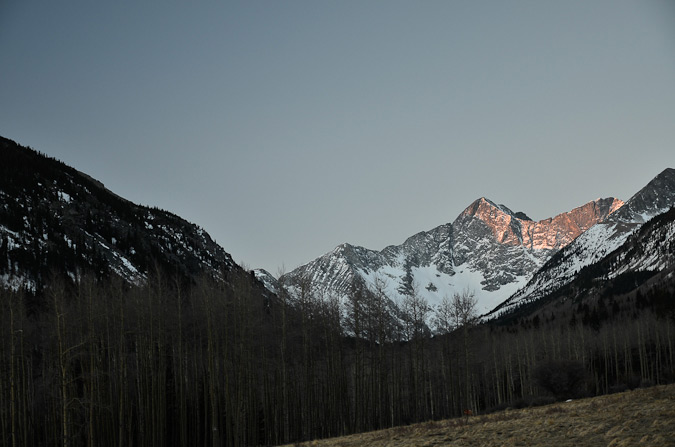
One thing you should know about both Ethan and I is that our first passion is hiking but a close second for both of us is photography. Last year, Ethan purchased a very nice Olympus camera on a deal that was too good to pass-up. I became increasingly jealous of the great images he'd been producing, so I set my sights on upgrading my old Sony DSC-F828 that I purchased in 2001. I was able to purchase a Nikon D7000 a couple of months ago and so I was really excited to finally put it to the test on a proper mountain ascent. Given our mutual love for photography, Ethan and I tend to take several breaks on our climbs to capture some photos along the way, and this trip was no different. In retrospect, I feel that I have a lot to learn about my new camera even though I felt really good about all of the settings after familiarizing myself with its features for the past couple of months. Many of my photos from this trip were blurry, under or over-exposed, and just plain not what I expected. I need a ton more practice!
Right away after setting off on the trail, Ethan and I were greeted by the sunrise kissing the top of Blanca Peak, one of the most magnificent mountains in Colorado. The vantage of Blanca Peak from the Huerfano Valley is one to behold, and I can't produce a much higher recommendation for a scenic location.
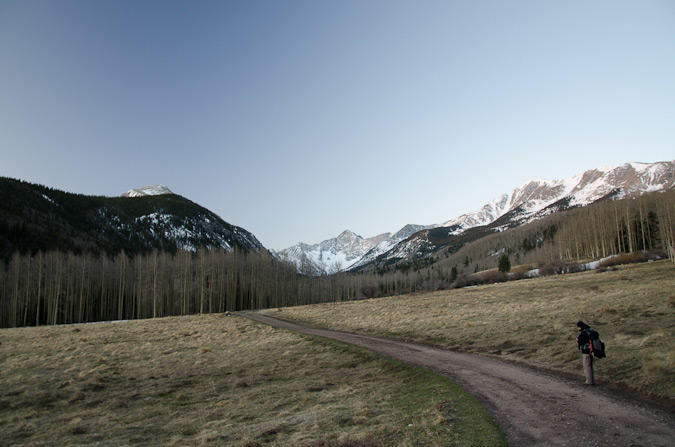
The road was almost completely clear of snow, minus a few large drifts that were in the shadows of trees. A large dead aspen tree had fallen to block the road about 1/8 of a mile from where we parked, so we were glad we parked where we did. Someone's going to have some fun with a chainsaw to get that tree out of the way.
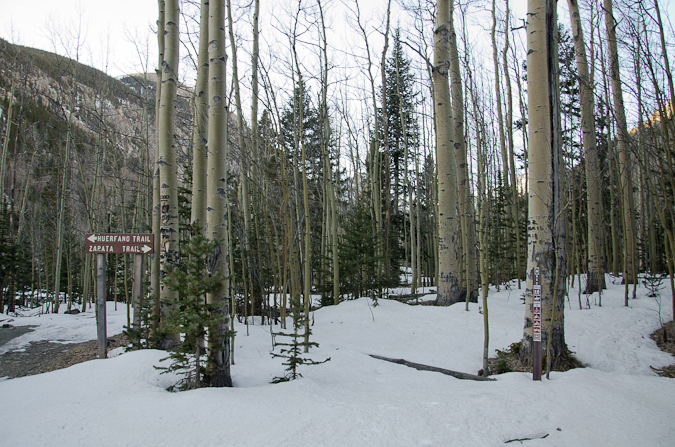
The standard route for California Peak takes you from the road up the Zapata Trail that weaves through the trees and intersects with a high meadow.
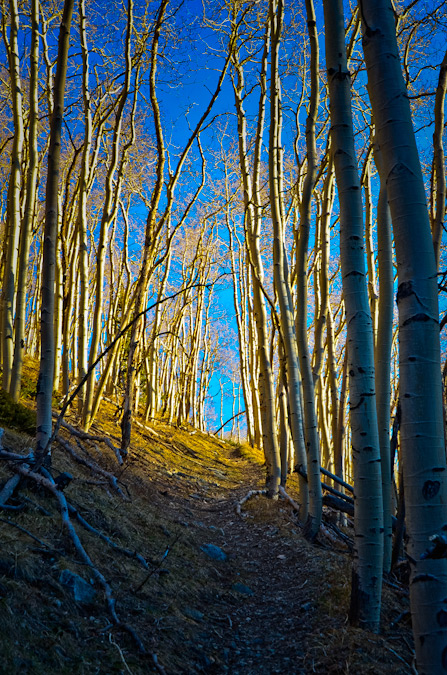
From there, the trail heads even higher on the eastern slopes of California Peak until dropping you onto a gentle ridge at 11,800 ft. From here, the idea is to follow the very long south ridge of California Peak all the way to the top, a ridge walk consisting of about 2,000 ft. in elevation gain over three miles. Our plan was to stick to the standard route as much as possible, taking detours when the trail was lost. As it turned out, the trail was quite visible for most of the hike, until we lost it just after the meadow. From here, we opted to head where we thought the trail went and then straight up a steep gully towards the ridge.
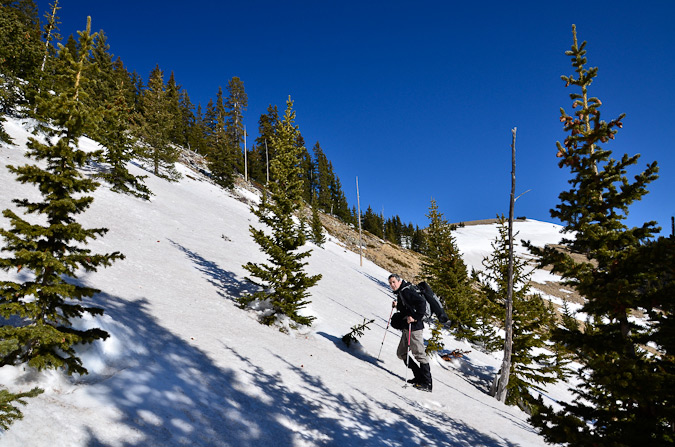
This gully ended up intersecting the actual trail eventually, and so we re-gained the trail and followed it to just below the ridge, where we trodded up a steep snow slop and over a small cornice to reach the ridge and the crazy wind that accompanied it.
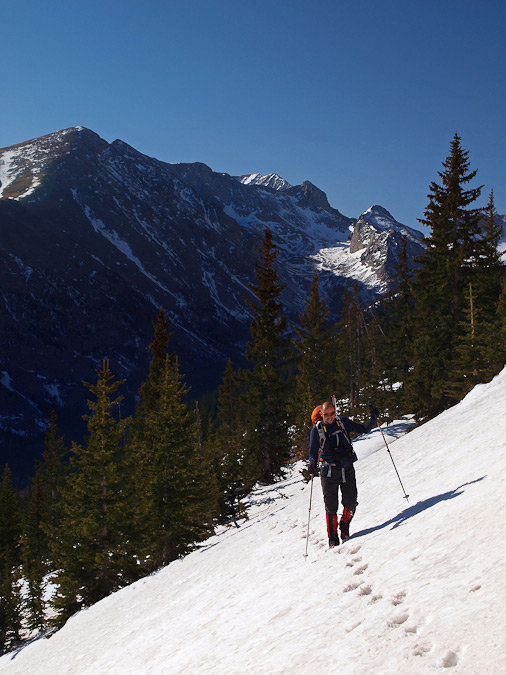
Here is an outline of the route we took for California Peak (click for higher resolution):
The trail offers some pretty nice views of the Huerfano Valley below, including a nice vantage of the Iron Nipple.
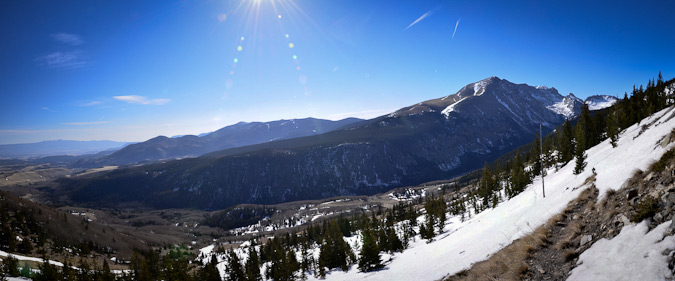
The wind on the ridge was pretty intense. It was not gusty, rather a constant ripping wind that had a biting chill to it. The wind was blowing across the ridge from the west, which explained the relatively little amount of snow on the ridge minus the drifted cornices on the very eastern edges of the ridge.
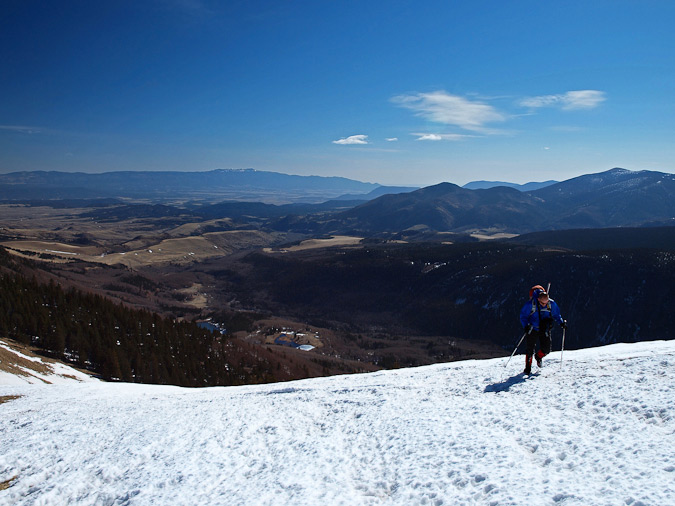
Ethan and I began hiking up the gentle ridge towards what we thought was the summit of Unnamed 13,476. Once we crested it, we realized it was merely one of several false summits leading up to California Peak. While these false summits were constantly demoralizing us, we were pleased and surprised by the breathtaking views of Crestone Peak, Crestone Needle, Mount Herard and the Great Sand Dunes National Park to the north.
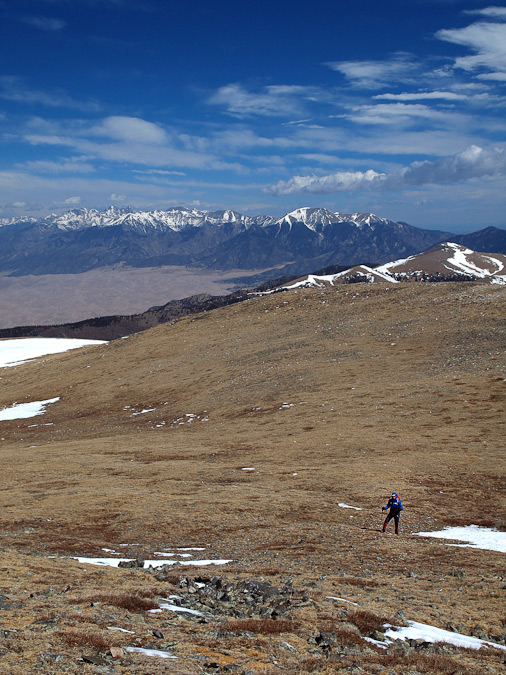

We reached the summit of another false summit and realized that California Peak was a long ways off yet. This ridge was quite a long approach indeed!
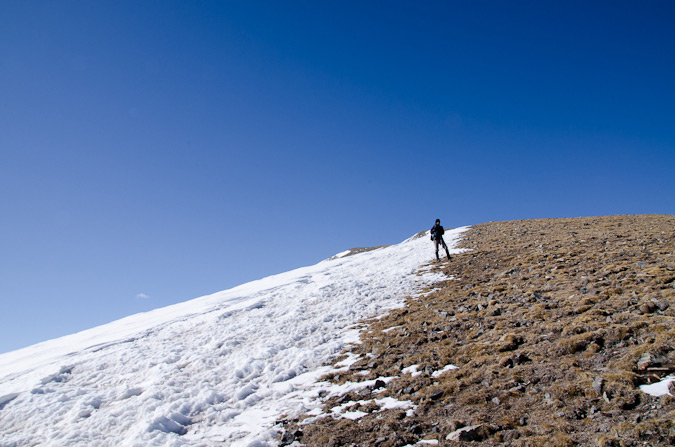
Once we reached the summit of Unnamed 13,476, we needed to stop because Ethan's hands had gone numb. This was surprising to both of us because he was wearing his brand new Marmot Windstopper gloves. Apparently they did not stop the mighty wind of the Sangre de Cristo Mountains. I went into my first aid kit and produced two Hand Warmer kits, one of which I had looted from a geocache find near Mount Shavano in 2009. The kits seemed to help Ethan, so we continued on up towards the next false summit.
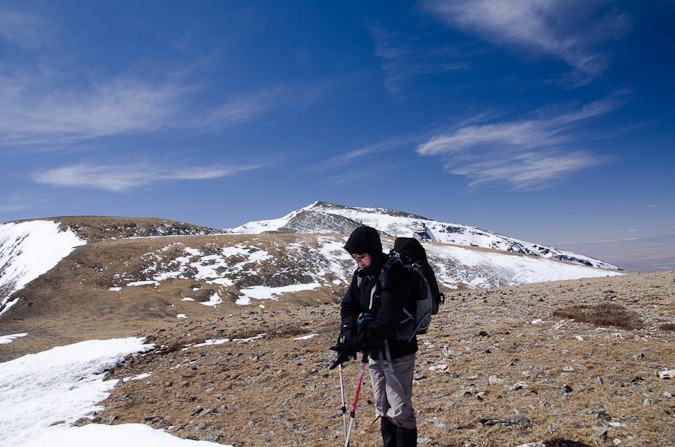
The summit block of California Peak was fairly steep, although nothing too crazy, and we were able to boulder hop our way through the shallow snow and to the summit by noon. Needless to say, the views of Blanca Peak, Ellingwood Point, Mount Lindsey, Iron Nipple and "Huerfano Peak" were outstanding.

It had appeared that no one else had signed the summit register since October, so it was cool being the first to sign it in 2011. We took several picutres and refueled for the descent. Despite the strong and chilly winds, the summit was great. It was awesome to be on my first top 100 mountain of 2011.
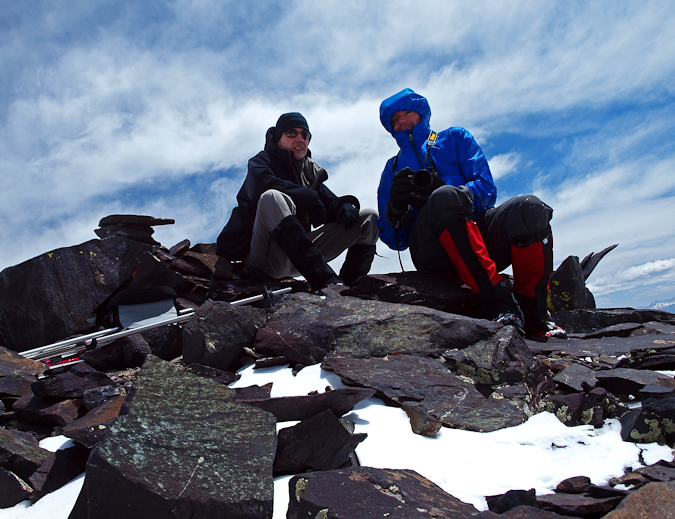
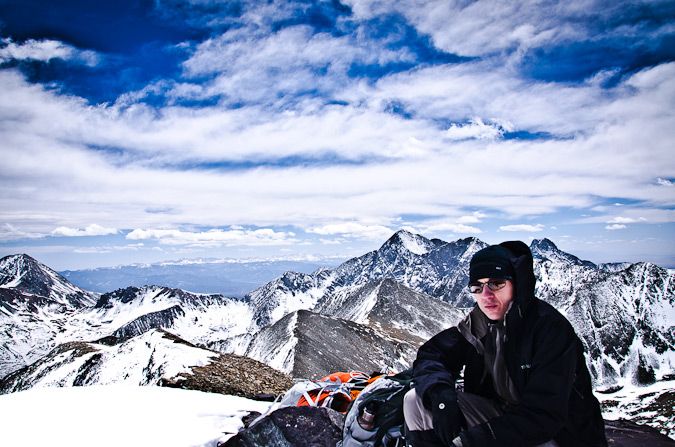
It was also really great to make the realization that I had just completed my 60th highest 100 summit of my life.
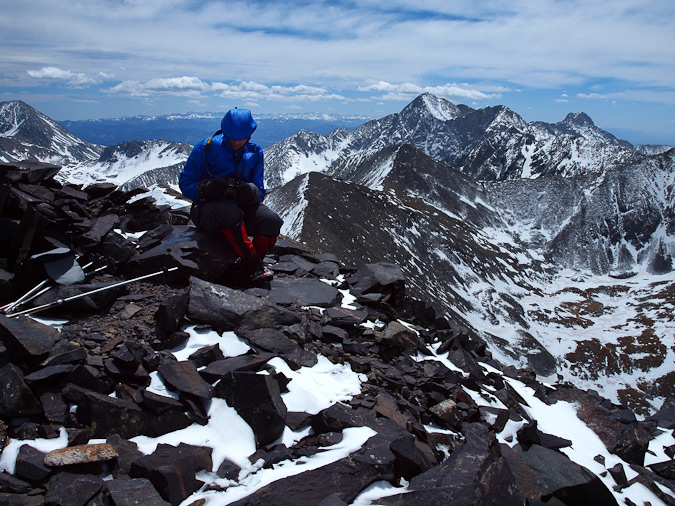
If all goes according to plan, by the end of 2011, I'll have only 15 of the highest 100 left to climb. My life-long dream is coming closer to completion. After soaking in the amazing views from the summit of California Peak, Ethan and I headed back down the ridge, but not before taking a 360 degree panoramic photo set:

Click HERE to view an interactive version of this photo (SMALLER FILE - 1.8 MB).
Click HERE to view an interactive version of this photo (LARGER FILE - 27.1 MB).
I was able to take two more sets of parting shots before we left the ridge, and I was quite pleased with the way in which they both turned out (one is the first photo in this trip report and the other is below).
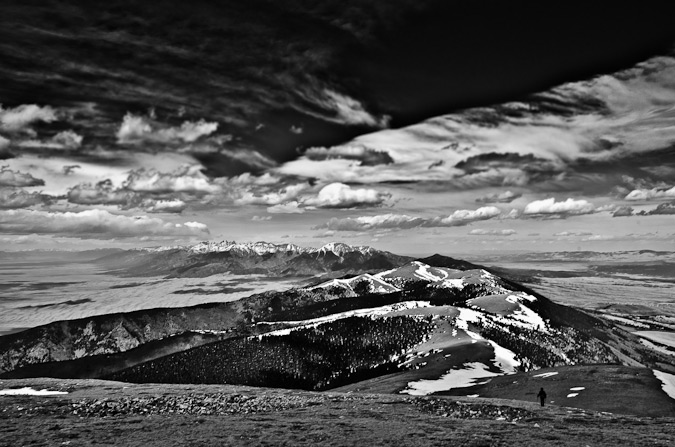
We found our trail in the snow without too much trouble and made quick time back to the road, and eventually, Ethan's car. Here is my favorite shot of Ethan's from the trip:
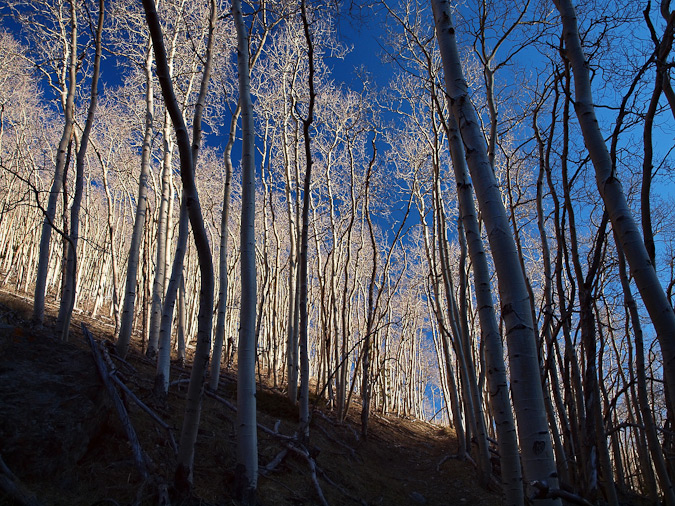
Here are some fun statistics from our hike:
Miles hiked: 11.5 round-trip
Total time: 10 hours
Total photos taken: 190 (far less than usual, despite having the new camera - shooting photos in the wind sucks)
I hope you enjoyed this adventure or that the information was useful for your planned hike of California Peak. As always, you can follow me on Twitter and Facebook. Please also remember, if you're planning on making any camera-related or outdoor-related purchases, use the links found HERE to support this site.
I look forward to your comments or questions regarding the hike or the methods used in any of the photos!
Top 5 Stunning Colorado Locations
Colorado is easily one of the most scenic places in the whole world, so creating this set of lists was not an easy task by any stretch of the imagination. Having lived in Colorado my whole life and having visited nearly every mountain range the State has to offer, I wanted to reflect on my absolute favorite locations as well as highlight the places I’ve not yet visited. If you’ve not yet had the opportunity to visit some of these places, I would highly recommend that you do so immediately! Without further ado, here is my list of the top five stunning locations in Colorado that I have visited:
- Vestal Basin. Vestal Basin is a very remote valley located deep within the Weminuche Wilderness Area 32 miles northeast of Durango, Colorado. The surrounding mountains are members of the Grenadier Range, which is a sub-range of the San Juan Mountains. Vestal Basin is home to one of the most aesthetically inspiring mountains in Colorado, Vestal Peak. Vestal Peak towers above the basin in a upwards sloping fashion and contains one of the most classic climbs in all of Colorado up what is known as Wham Ridge. Vestal Peak is easily recognized from all directions by the dramatic and awe-inspiring Wham Ridge. Next door to Vestal Peak lies the also impressive Arrow Peak, which also has similar traits, in that it rises to the sky in a very dramatic fashion. A trip up these two incredible peaks should be on any serious Colorado mountaineer’s bucket list.
- Capitol Lake / Elk Mountains. Capitol Lake sits at the base of Capitol Peak, located deep within the Elk Mountains 13 miles west of Aspen, Colorado. Access to some of Colorado’s most stunning peaks is granted from this location, including the challenging task of summiting Capitol Peak via its famous Knife Edge. Once above tree-line, views of other famous peaks, such as The Maroon Bells and Pyramid Peak are seen to the southeast. The Elk Mountains are a truly magical place to behold.
- Mount Sneffels Wilderness Area. This pristine wilderness area is located 10 miles south of the town of Ridgway, Colorado in the San Juan Mountains. The area is home to the famous Yankee Boy Basin and several incredible mountains within the highest 100 of Colorado, including Mount Sneffels, Teakettle Mountain and Dallas Peak. Dallas Peak is arguably the most difficult mountain to climb out of the highest 100 in Colorado. The rugged terrain and incredible foliage located in this area are something every visitor to Colorado should take time to see. Especially beautiful in the fall, the wilderness area’s aspen trees change to a magical display of deep gold, red and yellow, all with the dramatic and spectacular Mount Sneffels in the background. This area is a must-see for natives and out-of-state visitors alike.
- Colony Lakes / Cottonwood Creek. These two magical lakes rest at the eastern base of Crestone Needle, Crestone Peak and Humboldt Peak in the Sangre de Cristo Range, 13 miles southwest of the town of Westcliffe, Colorado. Cottonwood Creek runs on the western side of Crestone Peak and Crestone Needle and provides remote access to one of the densest, most pristine wilderness Colorado has to offer. Unfortunately, access to Cottonwood Creek is currently problematic due some private property complications at the trailhead near Crestone, Colorado. Hopefully this area will be opened back up someday so that others can fully appreciate the natural wonder and beauty this area has to offer. Access to the Colony Lakes is still available by way of a four-wheel drive road that recently was re-developed by the Forest Service. There is plenty of controversy surrounding this access point as well, due to damage to the ecosystem at the lakes above.
- Highland Mary Lakes. Highland Mary Lakes are some of the most remote lakes in Colorado located quite deep within the Weminuche Wilderness Area in the San Juan Mountains, southeast of Silverton, Colorado. The lakes are located on the Colorado Trail on a stretch of earth that is completely above tree-line for several miles in each direction. It is truly insane to be on such an elevated plateau with some of Colorado most splendid mountain vistas surrounding you. This location is a favorite attraction of mountain goats as well. An amazing 3-5 day backpacking trip can be made by traveling from north to south or south to north from the silverton-side trailhead of these lakes all the way to Vallecito Reservior or vice-versa. The trek is truly magnificent. Be sure to coordinate a car shuttle ahead of time!

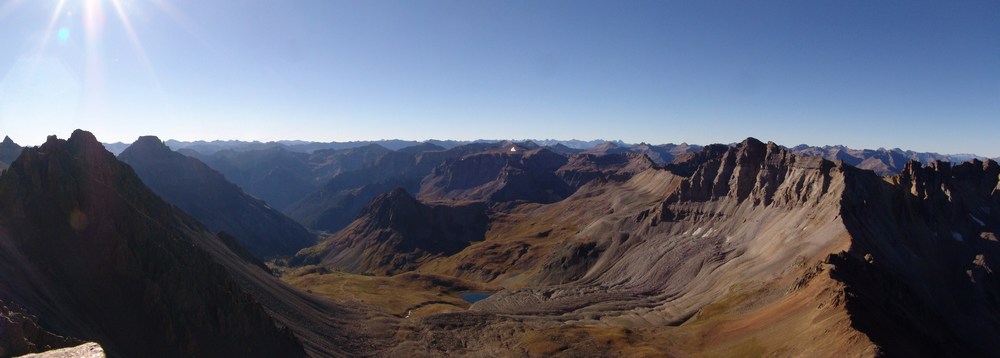
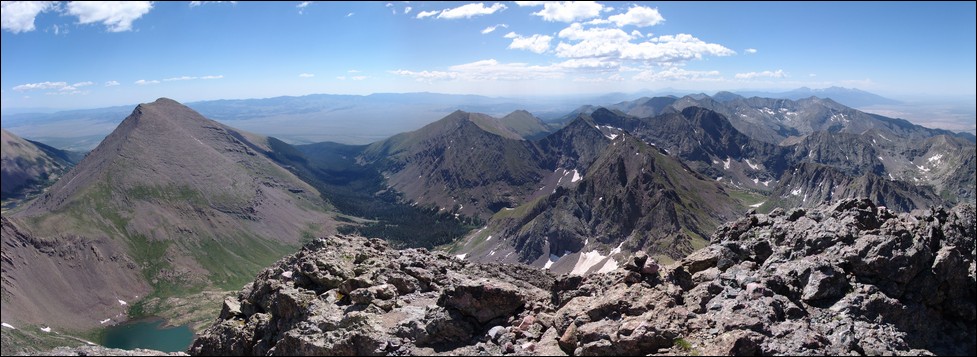
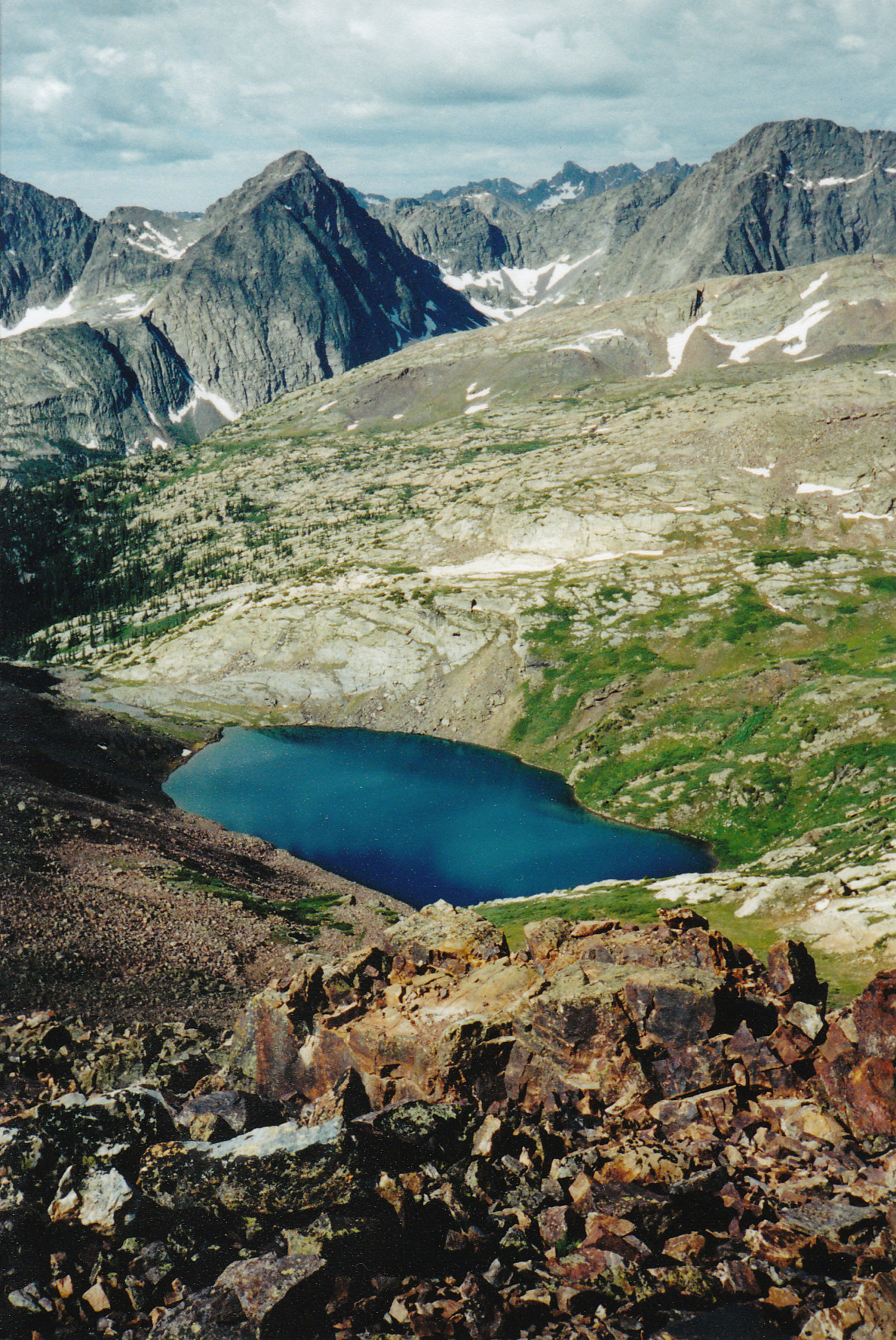
-
The top 5 places in Colorado that I’d like to visit but not had a chance to yet:
- Ice Lake Basin. Ice Lake Basin is a remote area west of Silverton, Colorado. From what I understand, this is one of the most incredible places in Colorado and I cannot wait to see it myself. The basin provides access to some of Colorado’s greatest peaks, including U.S. Grant Peak, Pilot Knob, Vermillion Peak and Fuller Peak.
- Chicago Basin. Chicago Basin is home to three of Colorado’s 14ers, Sunlight Peak, Windom Peak and Eolus Peak. Located deep within the San Juan Mountains’ Needle sub-range, these mountains are quite possibly some of the most photogenic and rugged looking out of any set in the State. While travel to the area is popular due to the access provided for the area’s 14ers, it is still tops on my list of places to visit.
- Indian Peaks Wilderness Area. Indian Peaks Wilderness Area is located northwest of Denver, Colorado, just south of Rocky Mountain National Park. While this area boasts no 14ers and only one peak over 13,500 ft, it is apparently a very pristine mountain range full of incredible hikes and challenging climbs.
- Gore Range. The Gore Range is a relatively unknown area north of Vail, Colorado and obtains some of Colorado’s most glaciated and rugged looking peaks. Many mountains in this range have never been named, mostly because of the remoteness of the area.
- West Elk Wilderness Area. This swath of wilderness is located north of Crested Butte, Colorado is home to some of the most insane images of autumn colors ever imaginable.
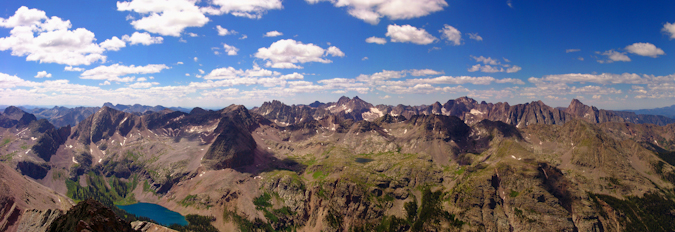

Photo by KAE Photography
What areas not covered have you been to that you’d like to share? Have any places you have yet to visit that you want to? I’d love to hear about your thoughts.
{fcomment}
Sangre de Cristo Range
The Sangre de Cristo Range spans over 180 miles from Colorado into New Mexico and is known by many locals for its solid congolmerate rock and its steep relief, rising out of the San Luis Valley. The festive town of Crestone sits at the base on the western side of the range and serves as a gateway to many of the lesser-known summits in the area. Another famous aspect of this mountain range is the Great Sand Dunes National Park, which rests at the western base of this range and can be seen from many of the summits of this range.
Wet Mountains
The Wet Mountains are one of the less heralded ranges in Colorado; however, they deserve some real attention from any series hiker or climber for several reasons. For starters, the summits of the Wet Mountains offer incredible views of the Sangre de Cristo range to the south and west. Secondly, the Wet mountains are home to one of the most prominent summits in all of Colorado - Greenhorn Mountain. Lastly, due to the lack of uber-high summits, the Wet Mountains are rarely travelled and offer solitude in the wonderfully fertile San Isabel National Forest. The Greenhorn Mountain Wilderness Area, a relatively new and small wilderness area created in 1993, lies within the Wet Mountains.



